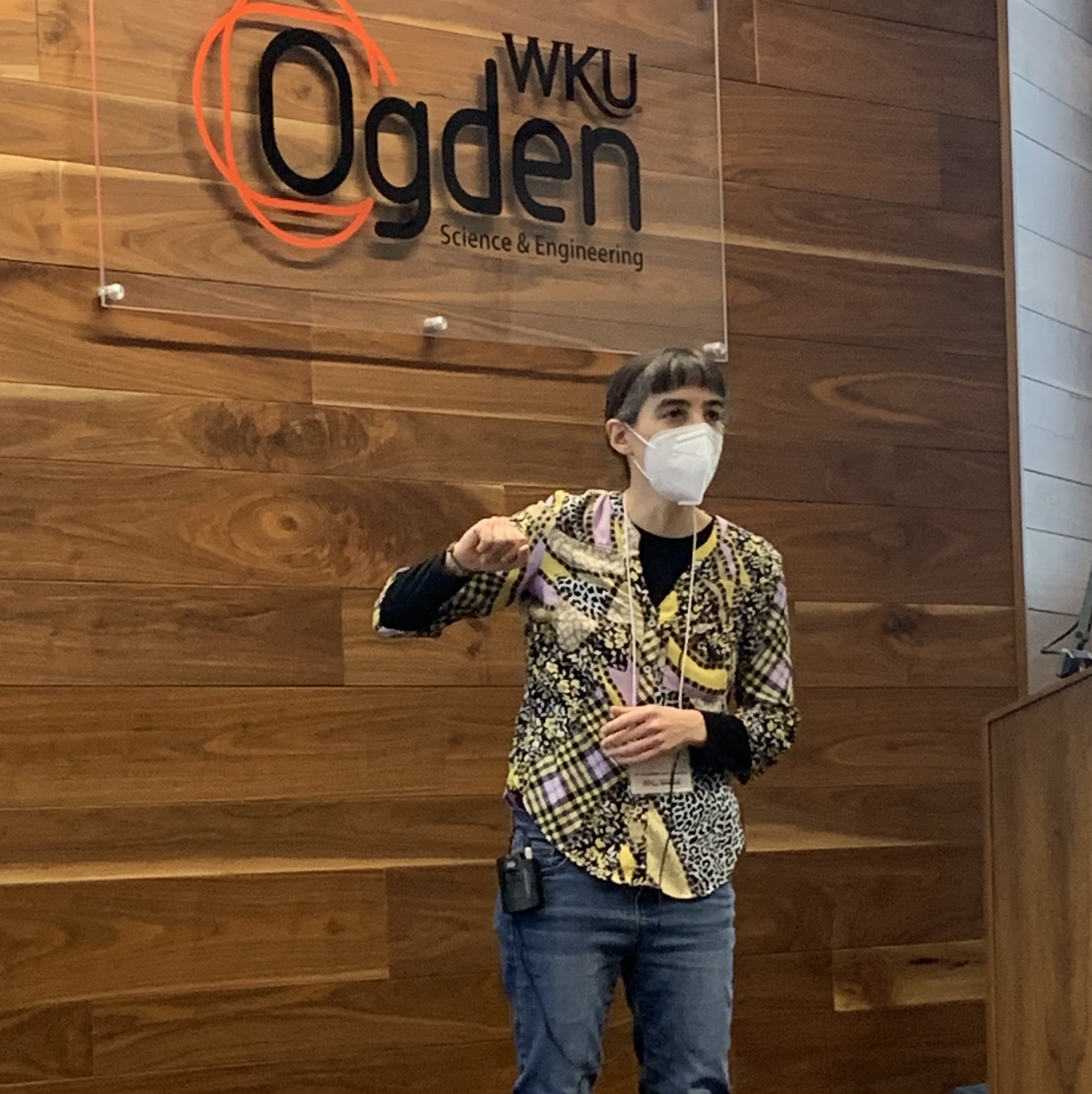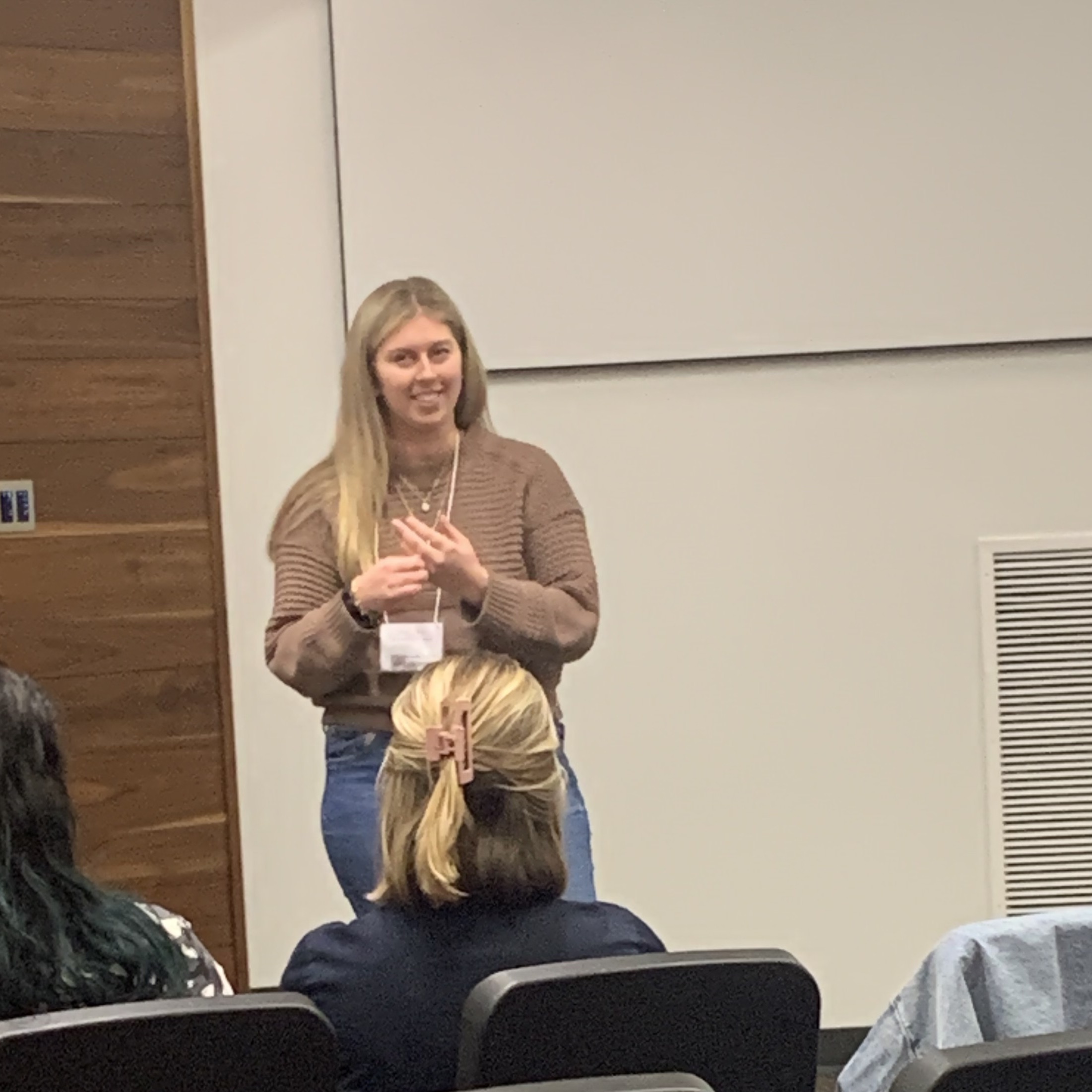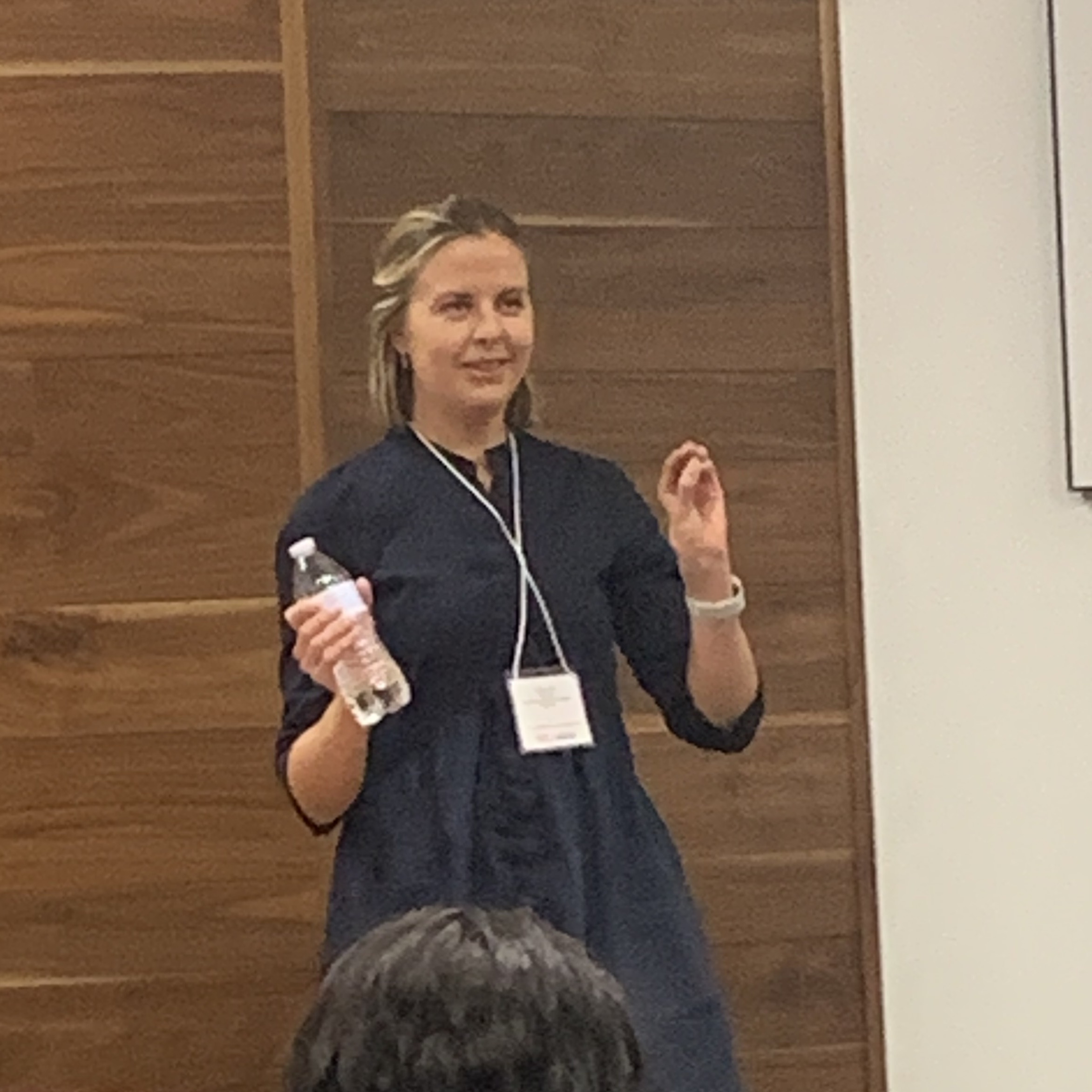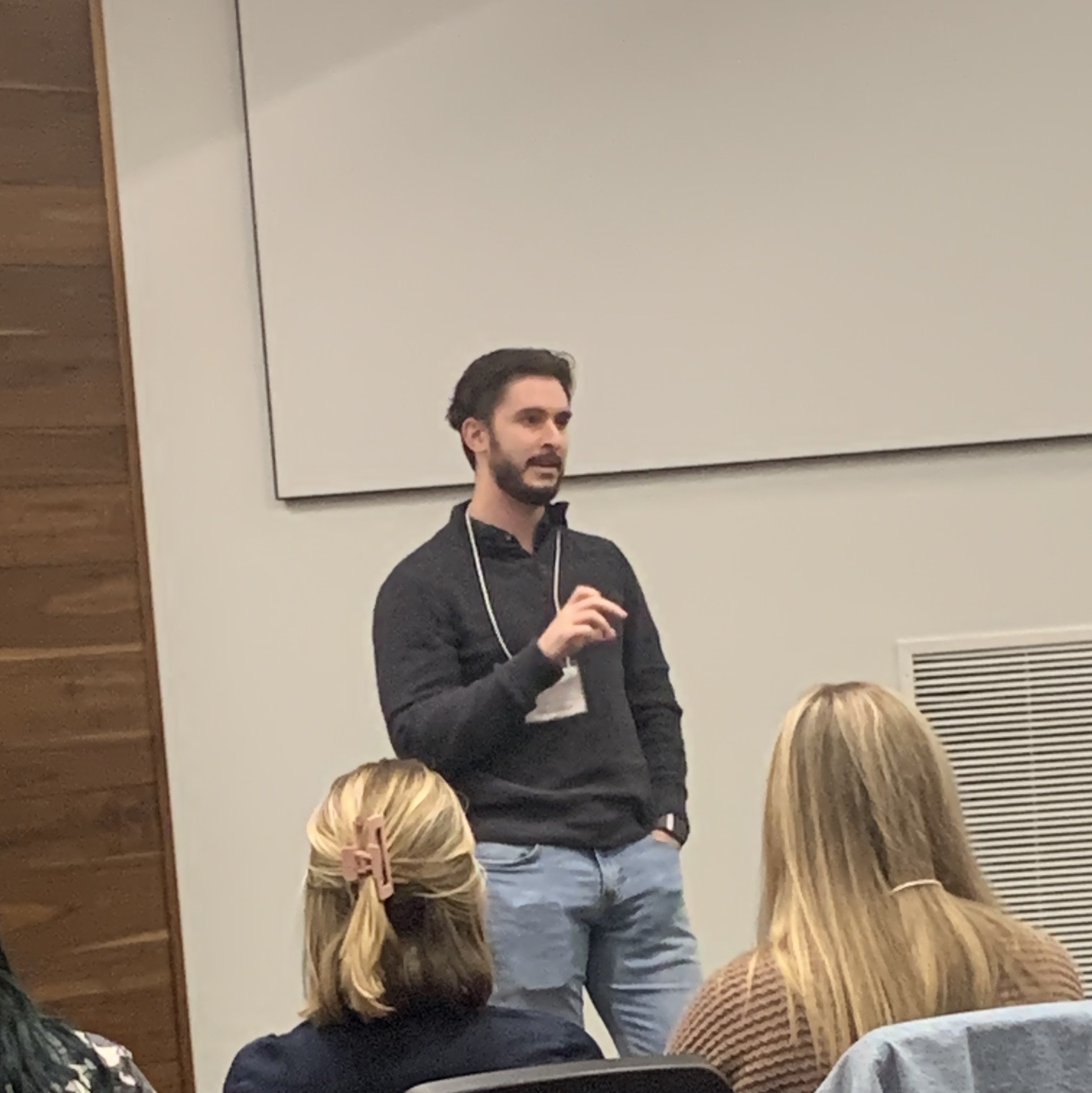42nd Annual WKU Mathematics Symposium Schedule and Abstracts
Schedule Overview
3:00pm (Friday)
Free registration is available throughout the whole event and begins at 3:00pm. It is located on the 1st floor of Ogden College Hall. There will be free refreshments.
3:45 - 4:00pm
Dr. David Brown, Dean, Ogden College of Science and Engineering
4:00 - 4:50pm
Ogden College Hall Auditorium
5:00 - 5:45pm
Ogden College Hall Auditorium
- Sarah Angelle (BA '18) - Teacher at Bowling Green High School
- Samantha Flener (BA '14) - Associate - Health Care Litigation & Disputes at Polsinelli
- Wilson Horner (BA '18, MS '21) - Data Scientist at Archer Daniel's Midland Company
- Rachel Lundy (BS '17) - Actuarial Analyst II - Individual Specialty Segment at Humana
5:50 - 6:10pm
Ogden College Hall Auditorium
6:10 - 6:40pm
Snell Hall
6:45 - 8:05pm
Sessions will be in Snell Hall. For specific information see below.
8:00 - 8:50am (Saturday)
Sessions will be in Snell Hall. For specific information see below.
8:50 - 9:15am
9:15 - 10:35am
Sessions will be in Snell Hall. For specific information see below.
11:00 - 11:50am
Ogden College Hall Auditorium
Detailed Schedule
Click on the Title and Presenter(s) to read the abstract of the presentation, and see a photo (when available).
Notes: (GA) Gatton Academy High School Student, (U) Undergraduate Student, (G) Graduate Student, (P) Postdoctoral Fellow, (F) Faculty, (I) Industry, * denotes presenter
Each 15-minute talk follows with a 5-minute Q&A. The next presenter should set up the presentation towards the end of the Q&A.
|
Time |
Room |
Title and Presenter(s) |
|
6:45-7:05pm (Friday) |
SH 1101 (Statistics) |
|
|
SH 1102 (Discrete Mathematics) |
The Single-Peaked Domain and Majority Rule by Flannery Wells* (G) |
|
|
SH 1103 (Pure Mathematics) |
||
|
SH 1108 (Applied Mathematics) |
||
|
7:15-7:35pm (Friday) |
SH 1101 (Statistics) |
Frequency Distributions Using the Five Platonic Solids by Lee Emanuel* (F) |
|
SH 1102 (Discrete Mathematics) |
||
|
SH 1103 (Pure Mathematics) |
||
|
SH 1108 (Applied Mathematics) |
||
|
7:45-8:05pm (Friday) |
SH 1101 (Statistics) |
|
|
SH 1102 (Discrete Mathematics) |
||
|
SH 1103 (Pure Mathematics) |
||
|
SH 1108 (Applied Mathematics) |
||
|
8:00-8:20am (Saturday) |
SH 1101 (Wolfram Coding Projects) |
|
|
SH 1102 (Discrete Mathematics) |
Strategies for d-Diet Chomp by Daniel Trudell* (U), Eric Gottlieb (F) |
|
|
SH 1103 (Pure Mathematics) |
Geometric Proof on Fermat’s Two Square Theorem by Brian Nguyen* (GA) |
|
|
SH 1108 (Applied Mathematics) |
A Partial Differential Equation Population Model on a Patchy Landscapes by Ryan St. Clair* (G) |
|
|
8:30-8:50am (Saturday) |
SH 1101 (Wolfram Coding Projects) |
|
|
SH 1102 (Discrete Mathematics) |
Flow, the game by Brian Nguyen* (GA) [this talk did not happen] |
|
|
SH 1103 (Pure Mathematics) |
Integrating Functions via the Hilbert Embedding by Lily Whitesell* (U) |
|
|
SH 1108 (Applied Mathematics) |
Solutions of First Order PDE with Two-Dimensional Dirac Delta Forcing Terms by Ian Robinson* (U) |
|
|
9:15-9:35am (Saturday) |
SH 1101 (Wolfram Coding Projects) |
Playing Pool on a Sphere - Among other Surfaces of Revolution by Ian Robinson* (U) |
|
SH 1102 (Discrete Mathematics) |
No talk |
|
|
SH 1103 (Pure Mathematics) |
Harmonic Functions: Their Properties and Applications by Wyatt Cooper* (U) |
|
|
SH 1108 (Applied Mathematics) |
Determining the Optimal Launch Conditions of Small-Scale Orbital Satellites by Nathan Hogg* (HS) |
|
|
9:45-10:05am (Saturday) |
SH 1101 (Wolfram Coding Projects) |
|
|
SH 1102 (Discrete Mathematics) |
||
|
SH 1103 (Pure Mathematics) |
Heavy Quarkonium Dynamics in Quantum Phase Space Representation by Gabriel Nowaskie* (GA) |
|
|
10:15-10:35am (Saturday)
|
SH 1101 (Wolfram Coding Projects) |
Title TBD by Ethan Kelly |
|
SH 1102 (Discrete Mathematics) |
Interpretation and Assumptions, conditional probability by Attila Pór* (F) |
|
|
SH 1103 (Pure Mathematics) |
||
|
SH 1108 (Applied Mathematics) |
||
|
OCH 1006 |
Abstracts for Presentations
Title: A new class of probability distributions via bi-elliptic functions
Presenters: Lukun Zheng* (F), Ngoc Nguyen (F)
Affiliation: Western Kentucky University
Abstract: In this paper, we develop a new family of distributions supported on a bounded interval with a probability density function that is constructed from two elliptical arcs. The distribution can take on a variety of shapes and has three basic parameters- minimum, maximum, and mode. We give general expression for the density and distribution function of the new distribution. Properties of this distribution are studied and parameter estimation is discussed. Monte Carlo simulation results show the performance of our estimators under many sets of situations. Further, we show the advantages of our distribution over the commonly used triangular distribution in approximating beta distributions.
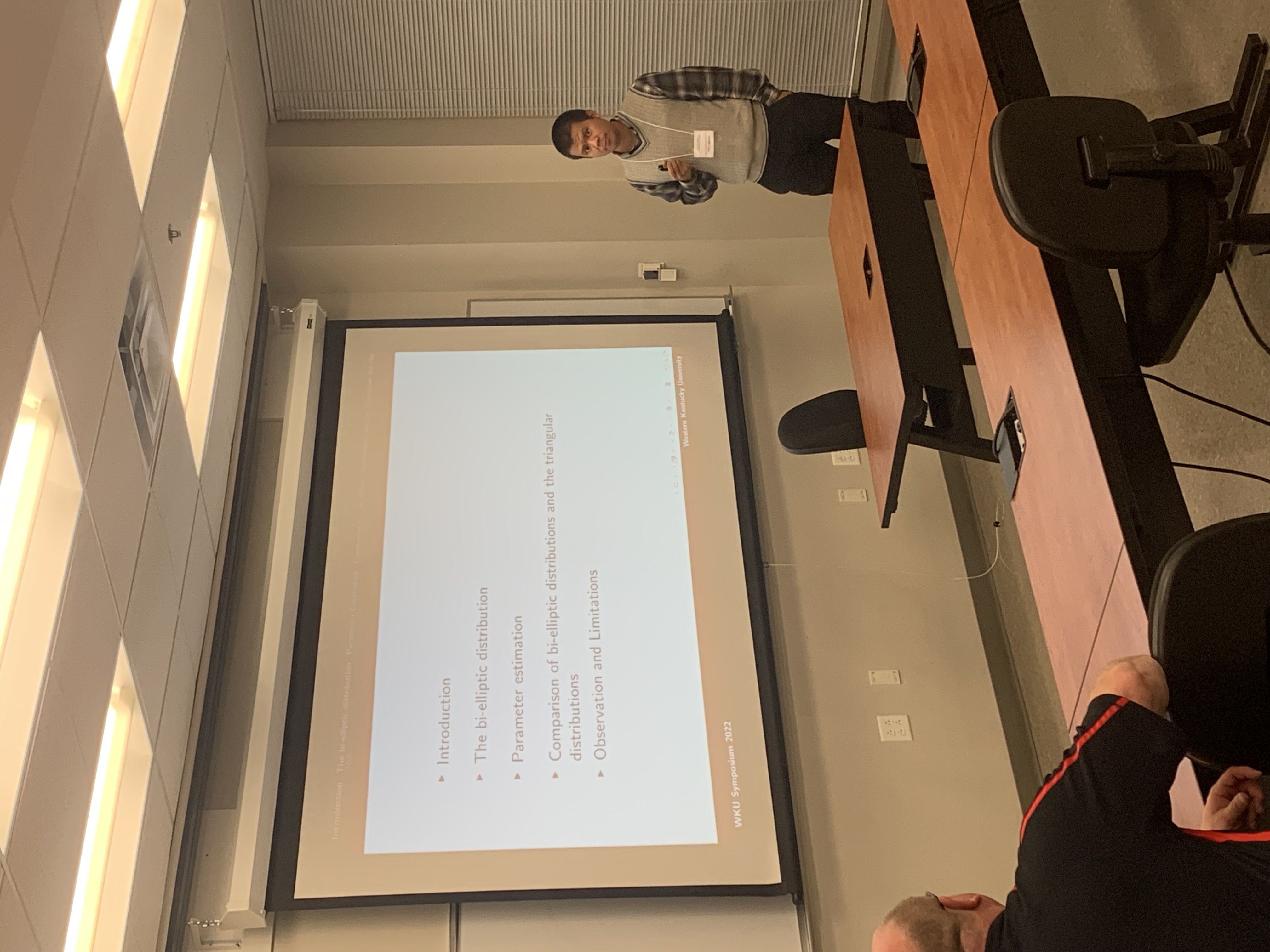
Click here to return to Detailed Schedule
Title: Frequency Distributions Using the Five Platonic Solids
Presenters: Lee Emanuel* (F)
Affiliation: Western Kentucky University
Abstract: The game of Farkle is played with six six-sided dice, playing this game with some
friends was the motivation for this project. I am going to consider the five platonic
solids and the frequency distribution of possible sums when rolling n n-sided dice
at a time. The five platonic solids are: tetrahedron (4), hexahedron or cube (6),
octahedron (8), dodecahedron (12), and icosahedron (20). The number of possible different
sums for each solid ranges from n up to n2. There will be a total of possible nn sums for each solid. The mean of an n sided die rolled i times is μ = ![]() . and similarly the standard deviation is σ =
. and similarly the standard deviation is σ = ![]() . The motivating conjecture for this project was that as the number of sides on the
dice increases the frequency distributions will appear to approximate a normal distribution
more closely.
. The motivating conjecture for this project was that as the number of sides on the
dice increases the frequency distributions will appear to approximate a normal distribution
more closely.
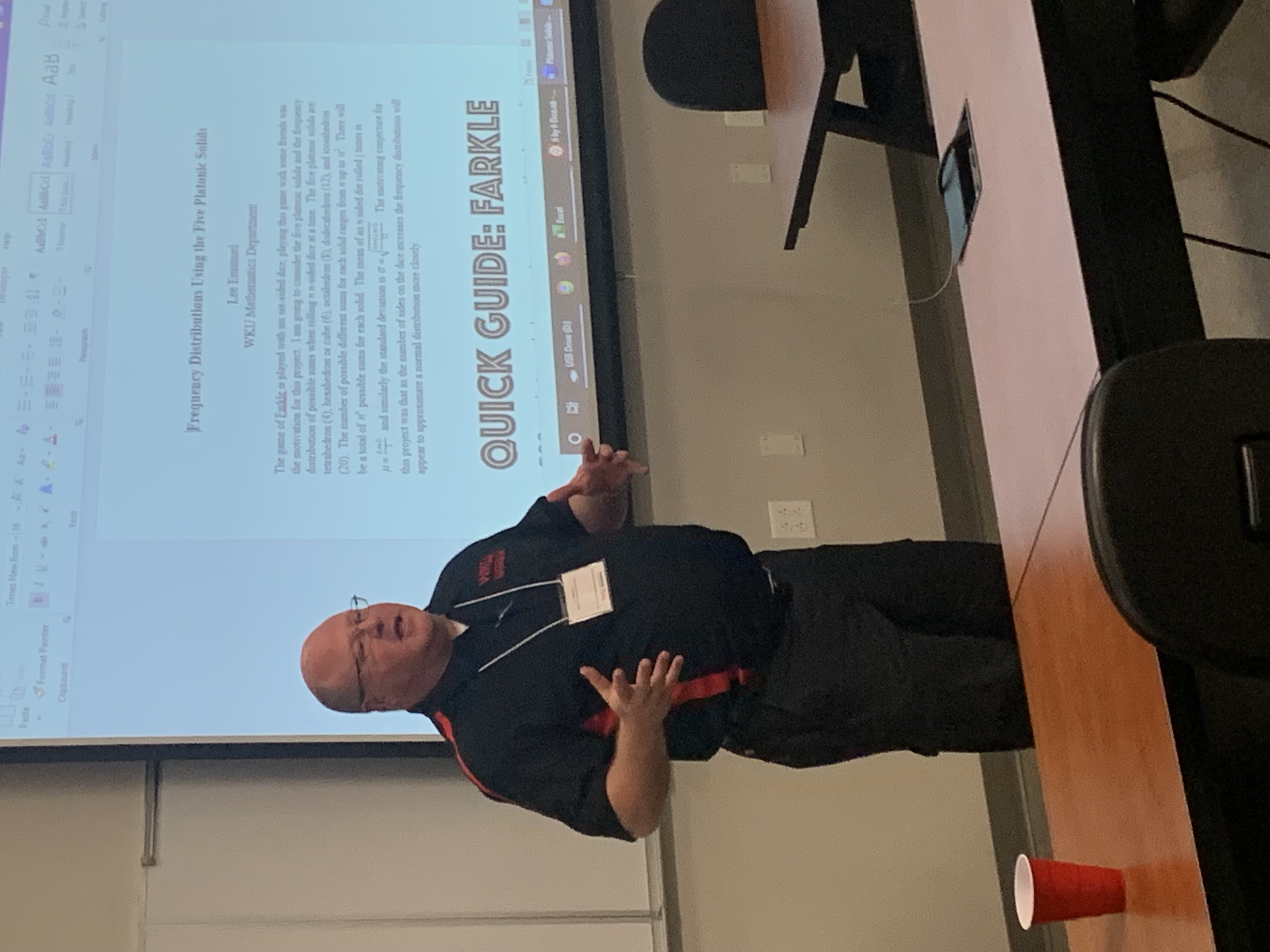
Click here to return to Detailed Schedule
Title: Factors Contributing to Religiosity
Presenters: Jaelyn Young* (U)
Affiliation: Western Kentucky University
Abstract: As an individual matures, there are countless aspects of their life that influence each and every decision made. This talk focuses on different factors contributing to one’s religiosity. Utilizing data from the 2018 General Social Survey and analysis with decision trees and logistic regressions, we examine this social topic.
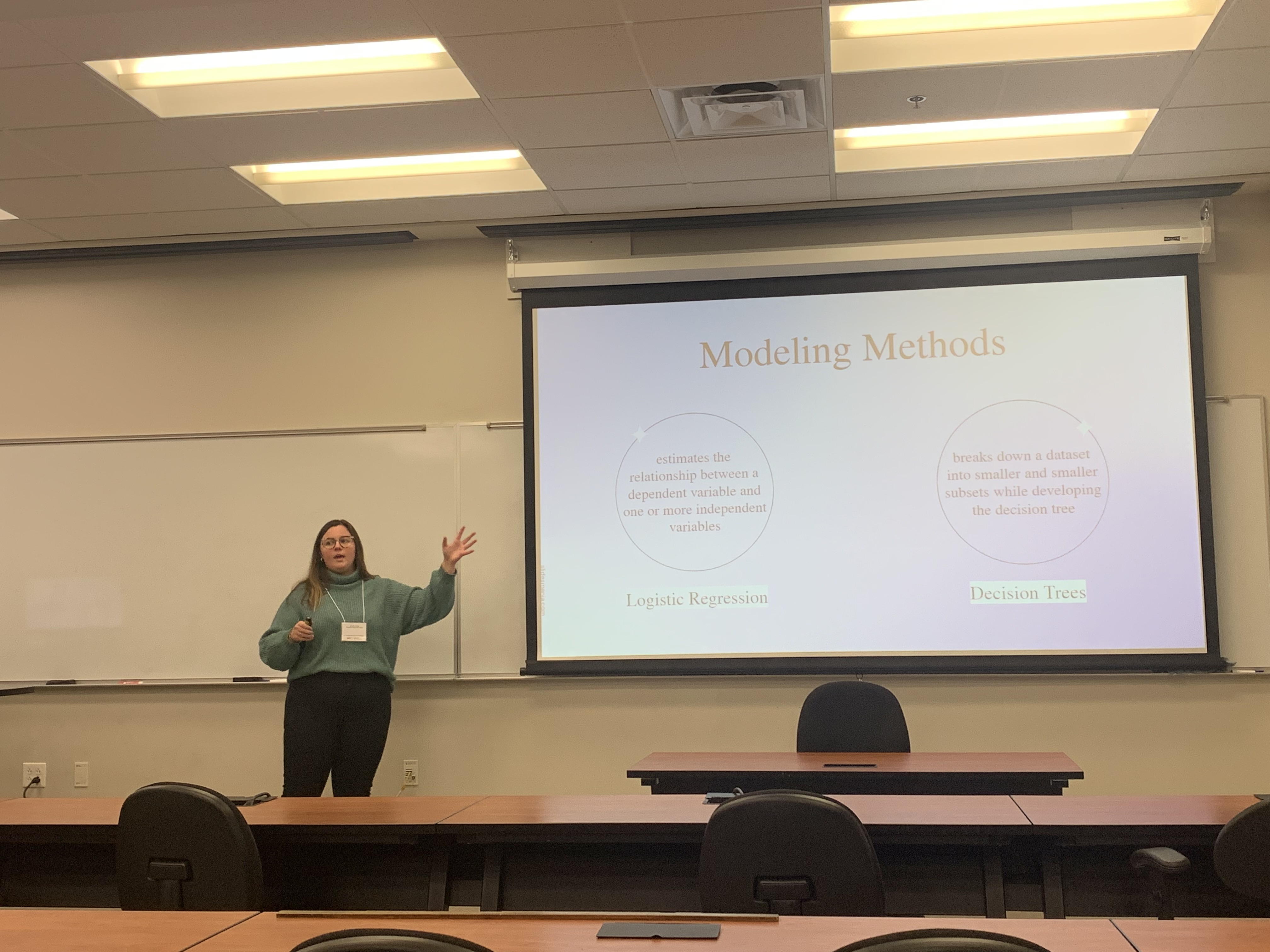
Click here to return to Detailed Schedule
Title: The Single-Peaked Domain and Majority Rule
Presenters: Flannery Wells* (G)
Affiliation: University of Louisville
Abstract: In mathematical social choice, a famous theorem attributed to Allan Gibbard and Mark Satterthwaite essentially states that for strict preferences on a set of three or more alternatives the only non-manipulable voting rule is a dictatorship. If we restrict the domain on which we consider voting rules, the question becomes more interesting. This talk will look into one such domain and a characterization of a rule that is non-dictatorial regardless of the size of the alternative set.
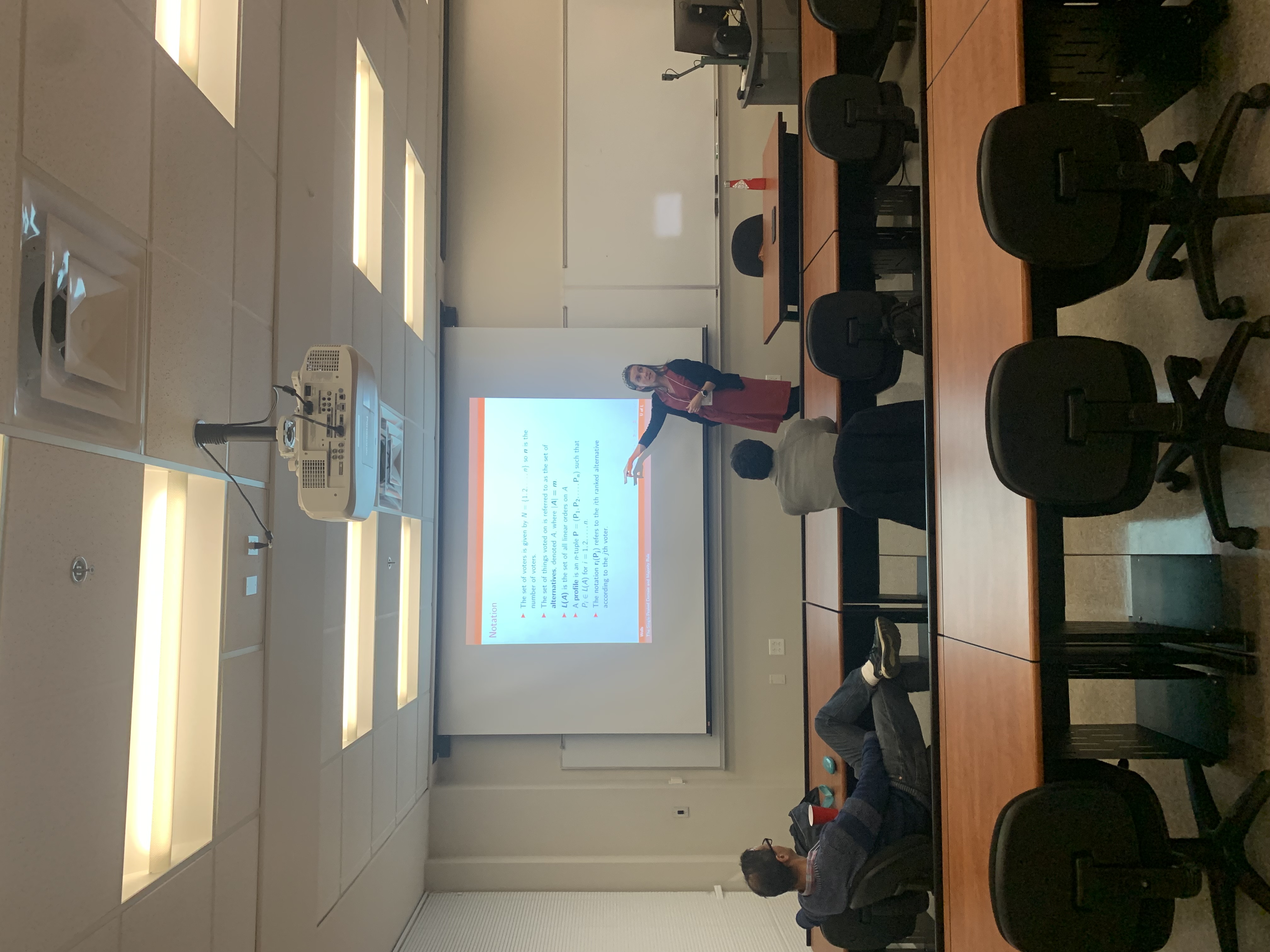
Click here to return to Detailed Schedule
Title: Helly-type theorems for the ordering of the vertices of a hypergraph
Presenters: Csaba Bíro* (F), Jenő Lehel, Géza Tóth
Affiliation: University of Louisville
Abstract: Let r ≥ 3, and let H be a complete r-uniform hypergraph such that two vertices are marked in each edge as its ‘boundary’ vertices. A linear ordering of the vertex set of H is called an agreeing linear order, if the vertices of each edge lie between its two boundary vertices. We prove the following Helly-type theorem: if there is an agreeing linear order on the vertex set of every subhypergraph of H with 2r - 2 vertices, then there is an agreeing linear order on the vertex set of H. We study three further variations of the problem, determining, in each case, if a Helly-type theorem exists.
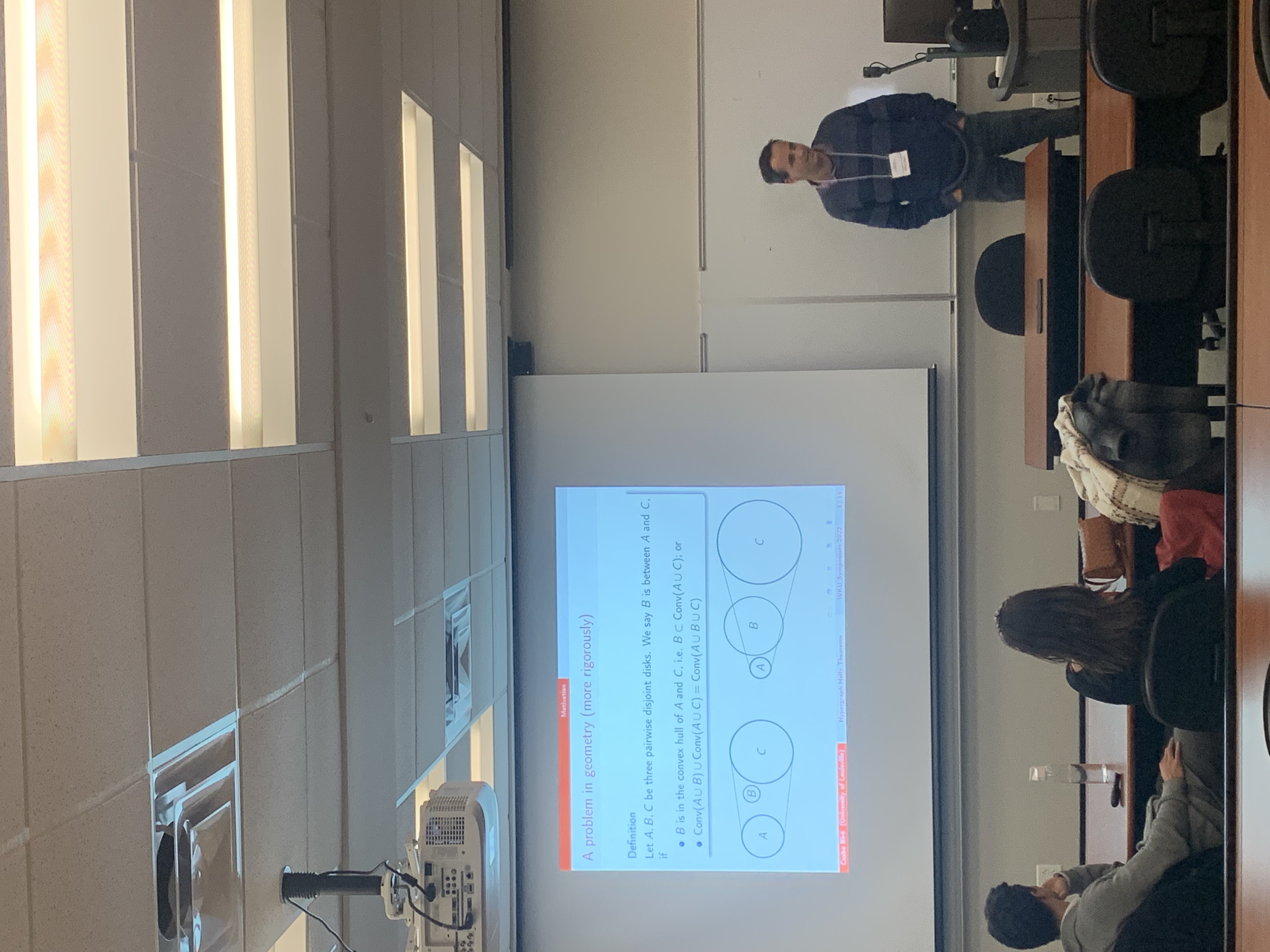
Click here to return to Detailed Schedule
Presenters: Holden Wells* (G)
Affiliation: University of Louisville
Abstract: Augustin Cauchy introduced in his most famous textbook four real valued functional equations designed to emphasize techniques in analysis. The first of which, f(x + y) = f(x) + f(y), is referred to as Cauchy’s (Functional) Equation. Many have since worked on modifying regularity assumptions and spaces surrounding Cauchy’s Equation. This talk will center on framing Cauchy’s Equation in the space of cumulative distribution functions, Delta +, and will examine the properties of approximate solutions.
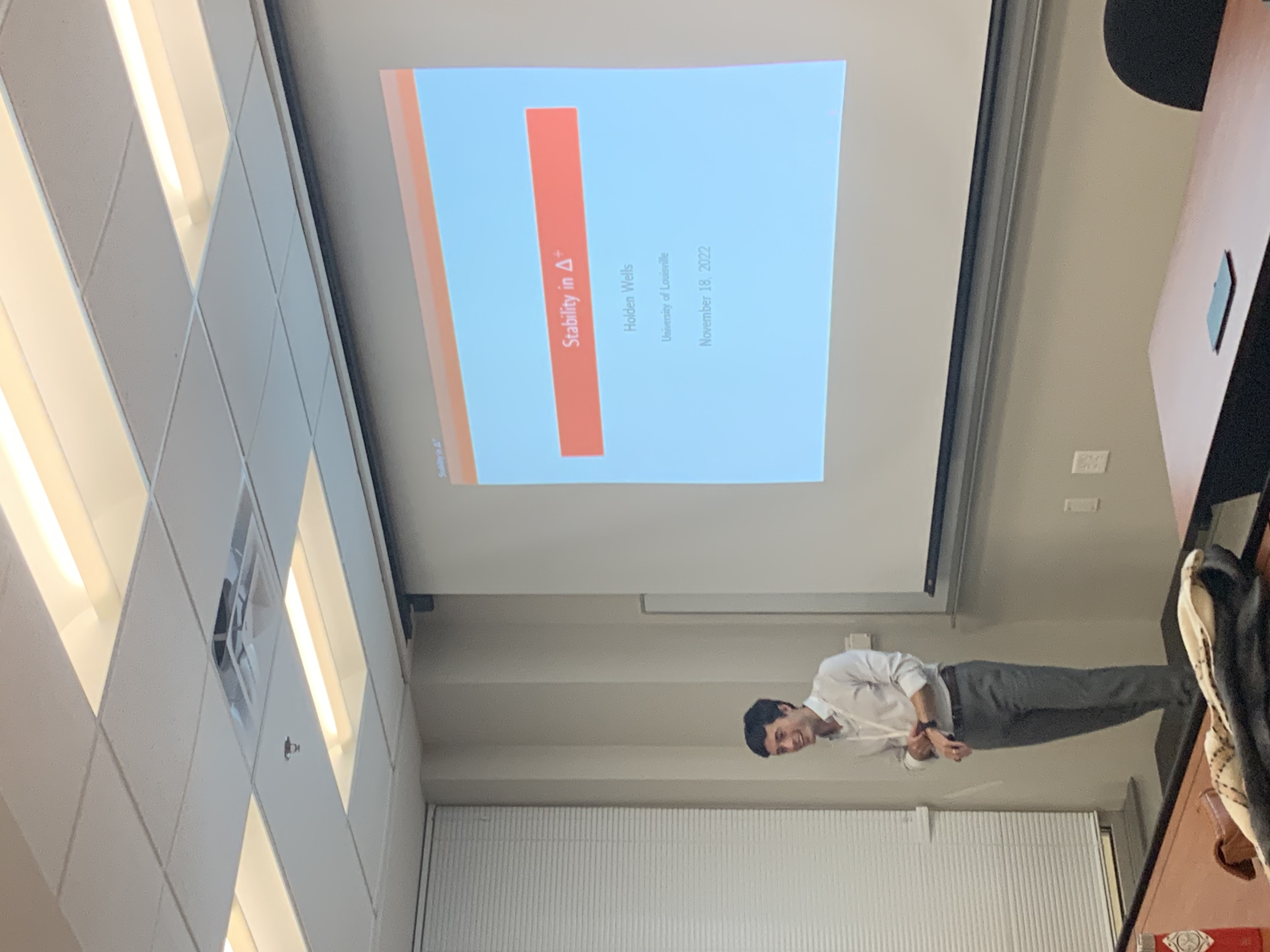
Click here to return to Detailed Schedule
Presenters: Claus Ernst* (F)
Affiliation: Western Kentucky University
Abstract: A spiral knot or link diagram is an oriented knot or link diagram where, when traversing through the planar diagram, the curvature does not change sign. An oriented knot or link type is called curly if it admits a spiral diagram with fewer maxima than the braid index of that knot or link type. We prove that all 4-plats with a braid index greater than three are curly. We also show that many alternating oriented Montesinos links are curly.
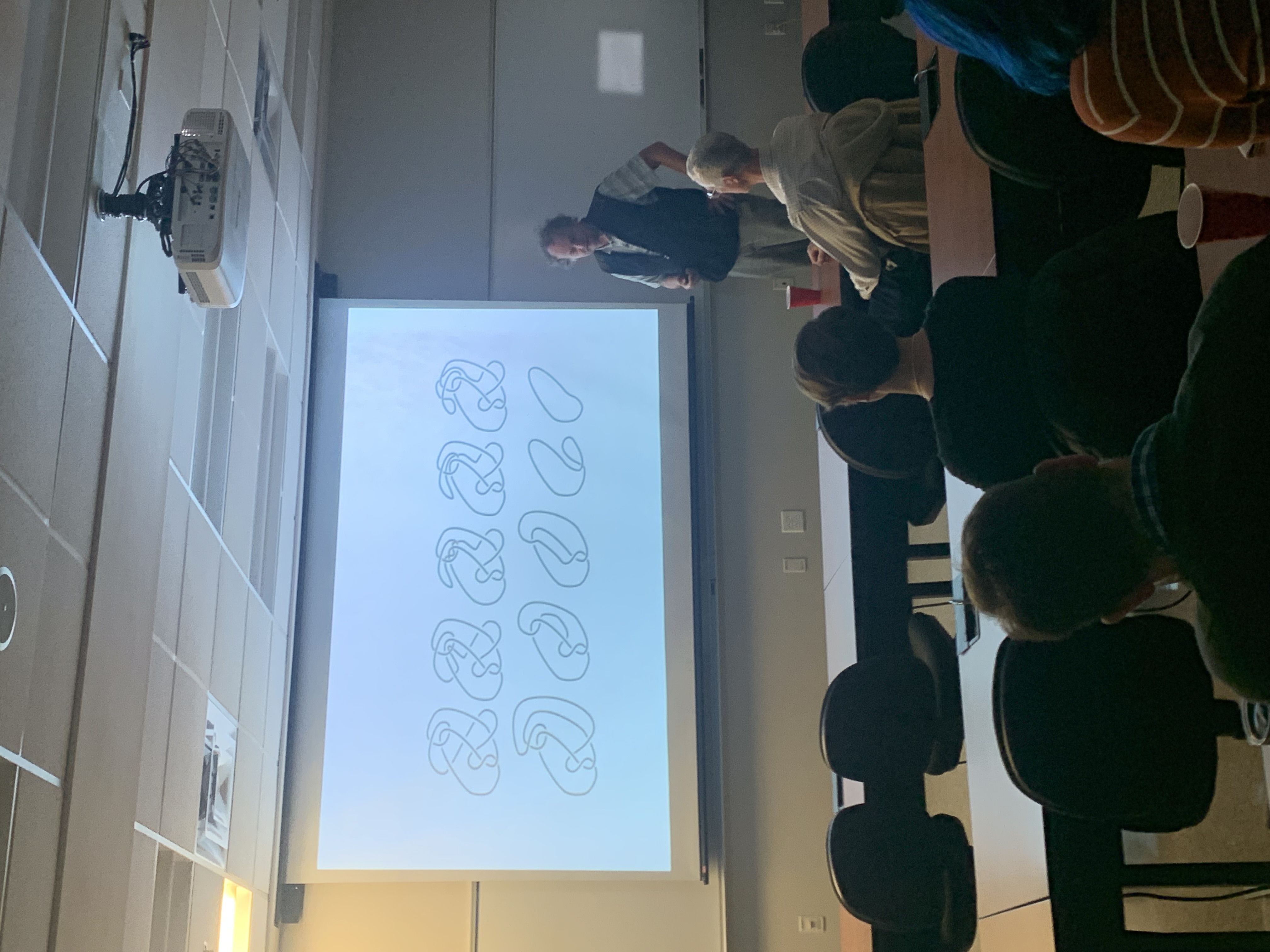
Click here to return to Detailed Schedule
Title: Introduction to Wavelets
Presenters: Cody Watkins* (G)
Affiliation: Murray State University
Abstract: We examine the idea of wavelets, defining them in terms of scaling functions, orthogonality, and refinability. We then briefly show that odd-length scaling functions do not exist. We follow this up by graphing select scaling functions and their corresponding wavelets, focusing specifically on the length-four wavelet. Finally, we glance at existing research into topics such as higher-length scaling functions, symmetry, and special wavelets and explain once more how wavelets help us approximate complex structures.
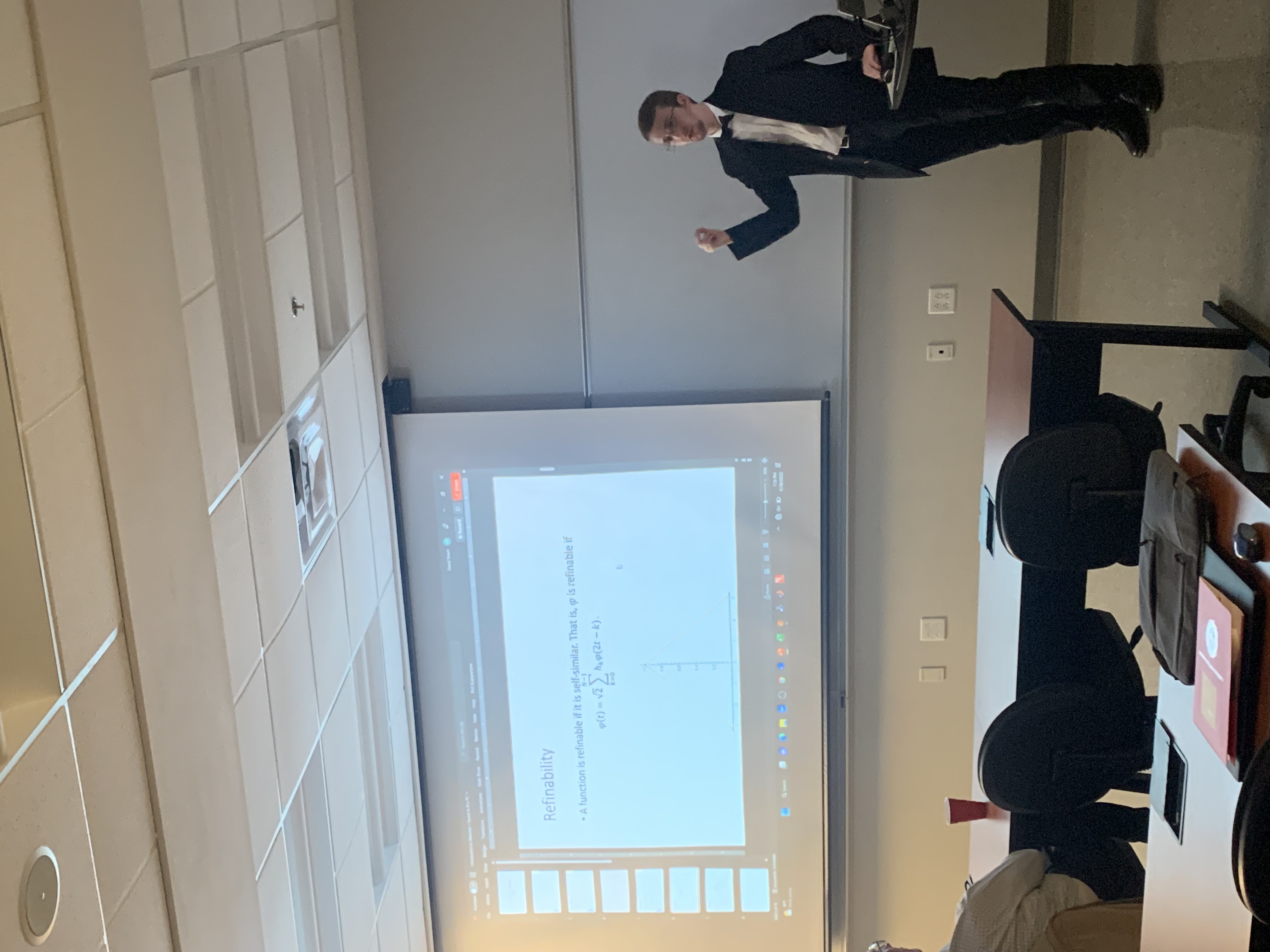
Click here to return to Detailed Schedule
Title: The Shape of Wavelet Space
Presenters: Dr. David Roach* (F)
Affiliation: Murray State University
Abstract: Wavelets are compactly supported functions that form an orthogonal basis for L2(R). In particular, they are self-referentially defined functions whose dilations by any power of two and integer shift are orthogonal to one another for any pair of dilations and shift. Wavelets can be classified into parameterized families based on their finite length which is defined as the number of non-zero coefficients in their associated dilation equation. These dilation coefficients can be considered a parameterized set of unit vectors that live on a hypersphere in Rn where n is the length of the wavelet. In this talk, we will look at ways to visualize the parameterized families of wavelets as points in R3 for various wavelet lengths with the hope to better understand the shape of wavelet space.
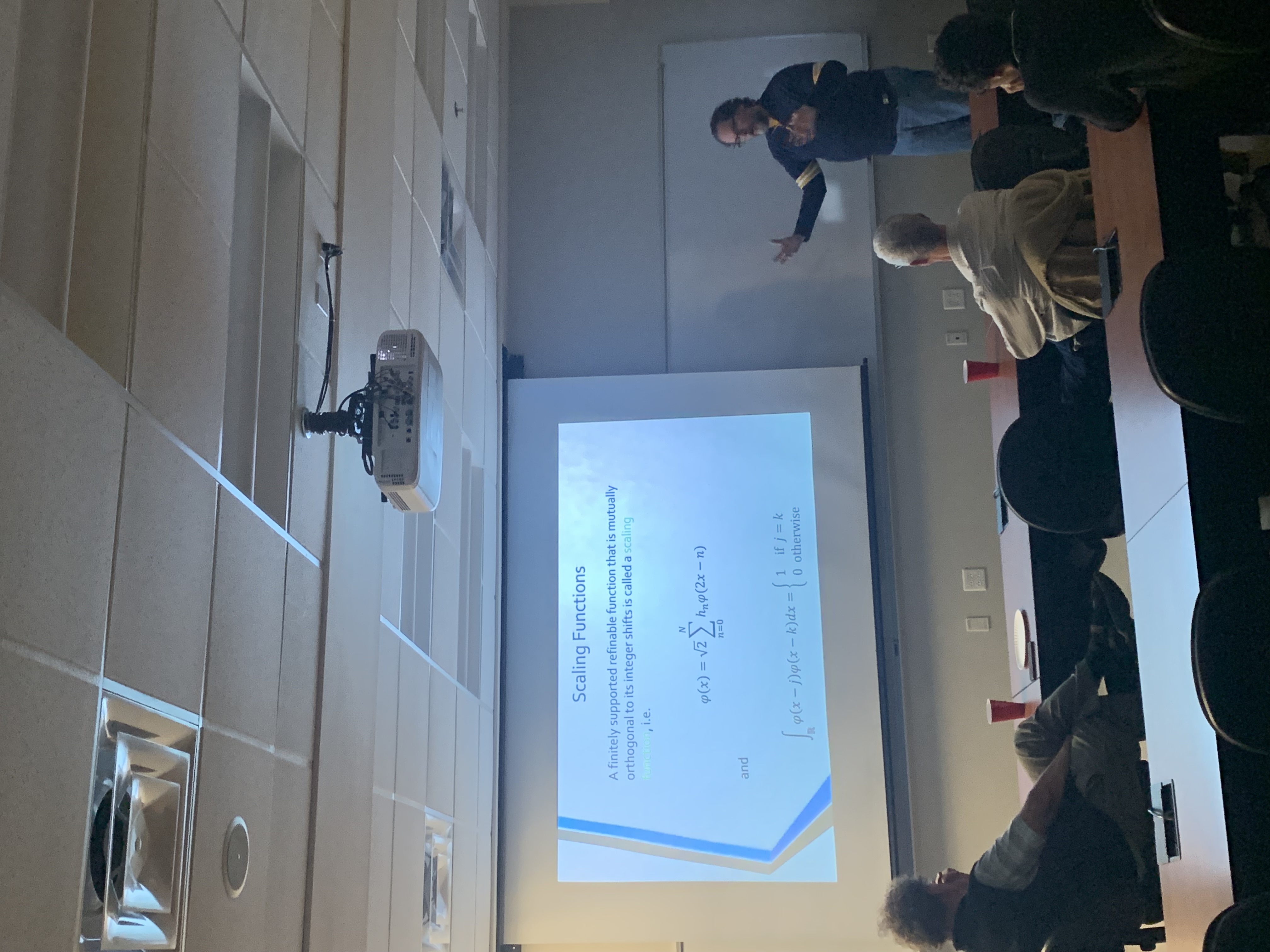
Click here to return to Detailed Schedule
Title: Selected Topics in Time-dependent Quantum Mechanics with Applications to Molecular Physics
Presenters: Jeremy B. Maddox* (F)
Affiliation: Western Kentucky University
Abstract: I would like to offer a special topics course (CHEM 475) and possibly a related computational laboratory (CHEM 476) covering an introduction to the theoretical and numerical methods used in the field of molecular quantum dynamics. The purpose of my presentation is to provide an overview of the proposed course with examples of the methods to be discussed, and to gauge the level of interest from the WKU Mathematics community. Topics include: the analytical properties of Gaussian wave packets and their phase-space representation; wave packet time-correlation functions and their Fourier transforms; a review of the mathematical formalism of quantum mechanics; exact and approximate solutions to the time-dependent Schrödinger equation (TDSE); spectral and pseudospectral numerical methods (discrete variable representations and fast Fourier transforms) for solving the TDSE; a survey of applications from the chemical physics literature involving one- and two-photon electronic spectroscopy, photodissociation, and reactive scattering.
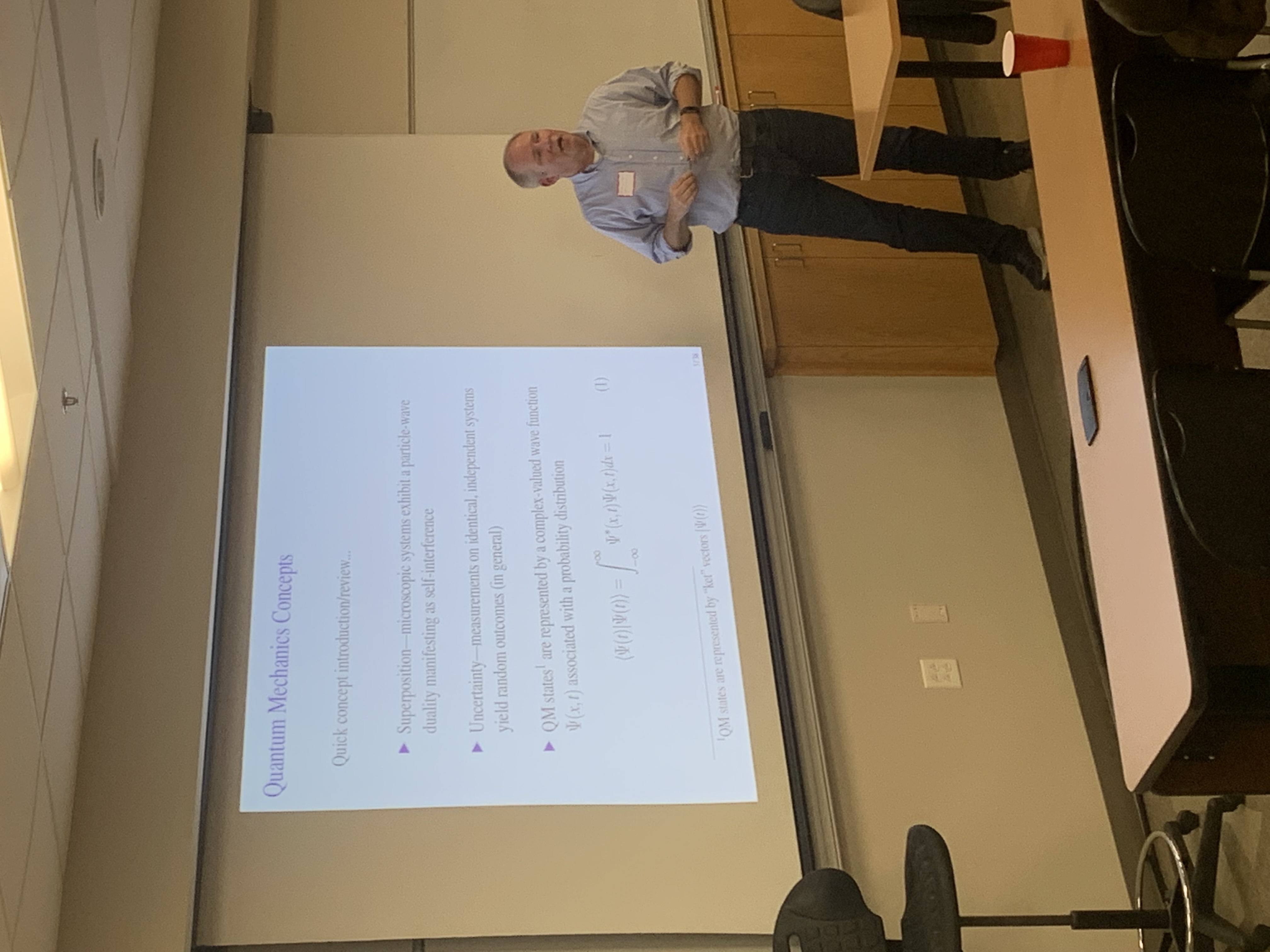
Click here to return to Detailed Schedule
Title:Properties of Time Series and Analysis in Mathematica
Presenters: Dunil Kasturiratna* (GA) and Kaden Yonts* (GA), Ngoc Nguyen (F)
Affiliation: Gatton Academy
Abstract: Often, mathematical ideas are hidden behind complex textbooks, thus depriving students of an experience in which they create and refine ideas for themselves. Time series analysis is one such topic where the available resources are difficult to refine through self-experimentation. This paper describes a user interactive Mathematica program intended to showcase the relationship between parameters and the behavior and properties of time series. Three main parts: simulation, estimation, and prediction, are used to formulate predictive models in time series analysis. Some facets of time series analysis include: the random walk model, ACF, and the AR model.
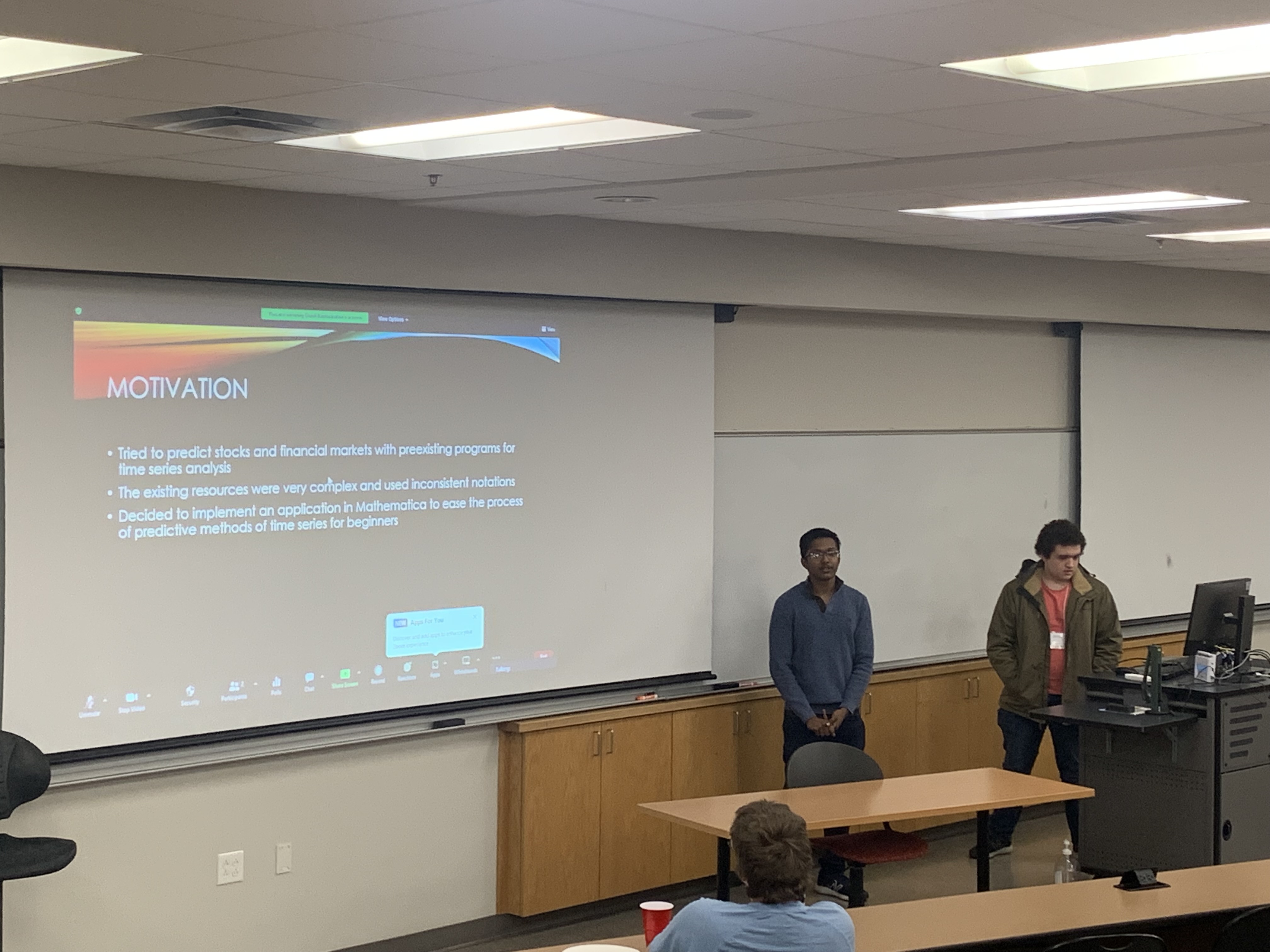
Click here to return to Detailed Schedule
Presenters: Mark P. Robinson* (F)
Affiliation: Western Kentucky University
Abstract: This presentation examines the numerical solution of systems of ordinary differential equations (ODEs) and systems of differential-algebraic equations (DAEs). A DAE system consists of a mixture of ordinary differential equations and algebraic equations. Basic principles and some example problems are considered.
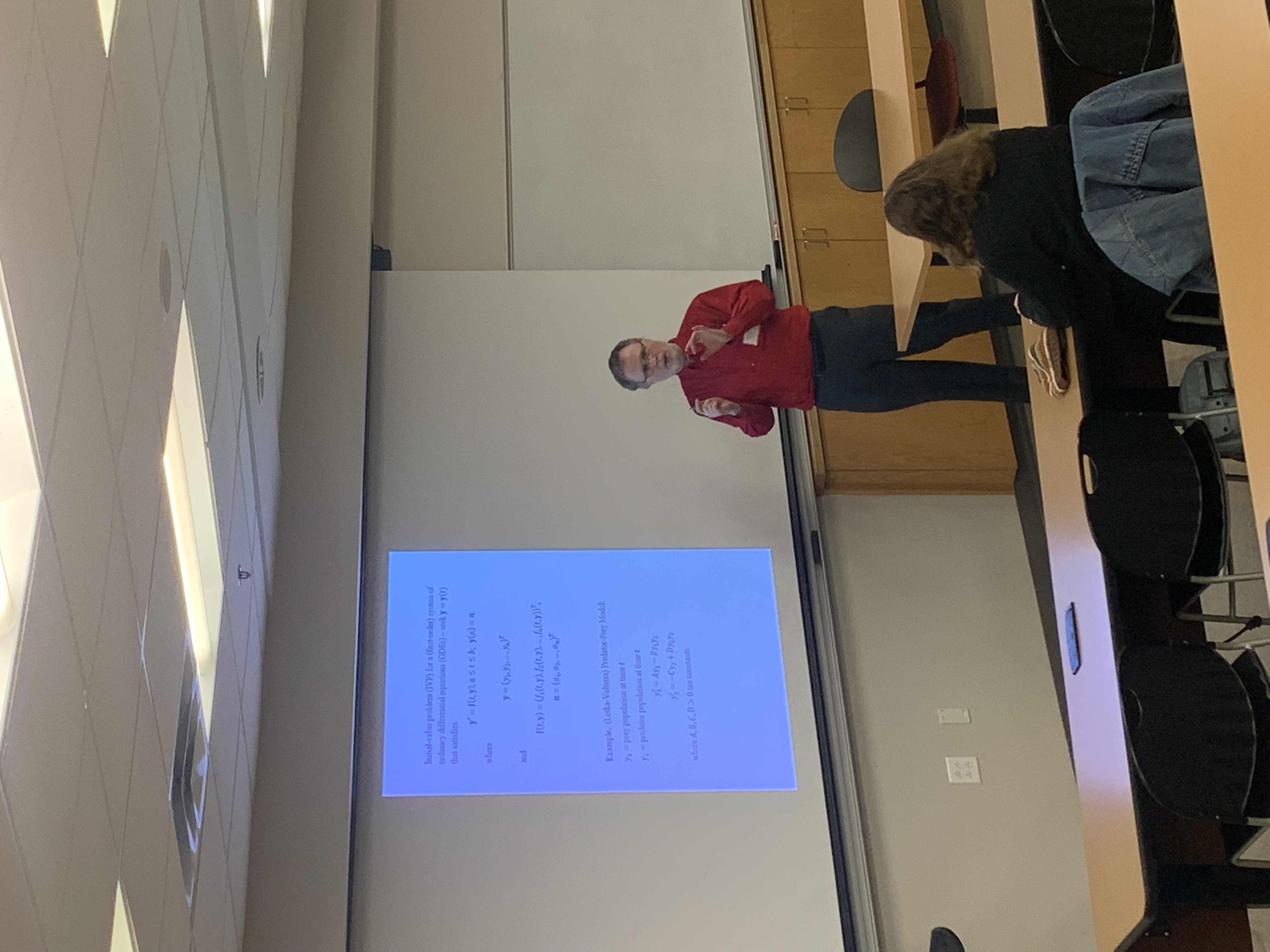
Click here to return to Detailed Schedule
Presenters: Jacob Walterman* (U), Ahmet Kaan Aydin (G), Matthew Poynter (U), Ahmet Ozkan Ozer (F)
Affiliation: Western Kentucky University
Abstract: Consider novel Finite Difference and Finite Element-based model reductions of the infamous one-dimensional wave equation accurately predicting vibrations on a string where the free end of the string is observed/controlled by a collocated sensor/actuator. First, it is shown that the feedback sensor placed at the tip of the string can be designed by eliminating the short wavelength and high-frequency components of the solutions through the direct Fourier filtering technique. This way, the sensor becomes more able to distinguish the vibrational frequencies from one another, and this filtered sensor data is fed back to the controller, resulting in all the vibrations on the string being successfully suppressed exponentially fast, replicating the real-world dynamics of the wave equation. Another approach, based on order reduction, accurately simulates the dynamics without the need for direct filtering. Finally, all Mathematica simulations are published open source via the Wolfram Demonstrations Project (WDP): the demonstrated code being used in the presentation is already published at the Wolfram’ Demonstrations Project website.
https://demonstrations.wolfram.com/StabilizationOfTheWaveEquationByDirectFourierFiltering/
This project is sponsored by the National Science Foundation under Cooperative Agreement No. 1849213.
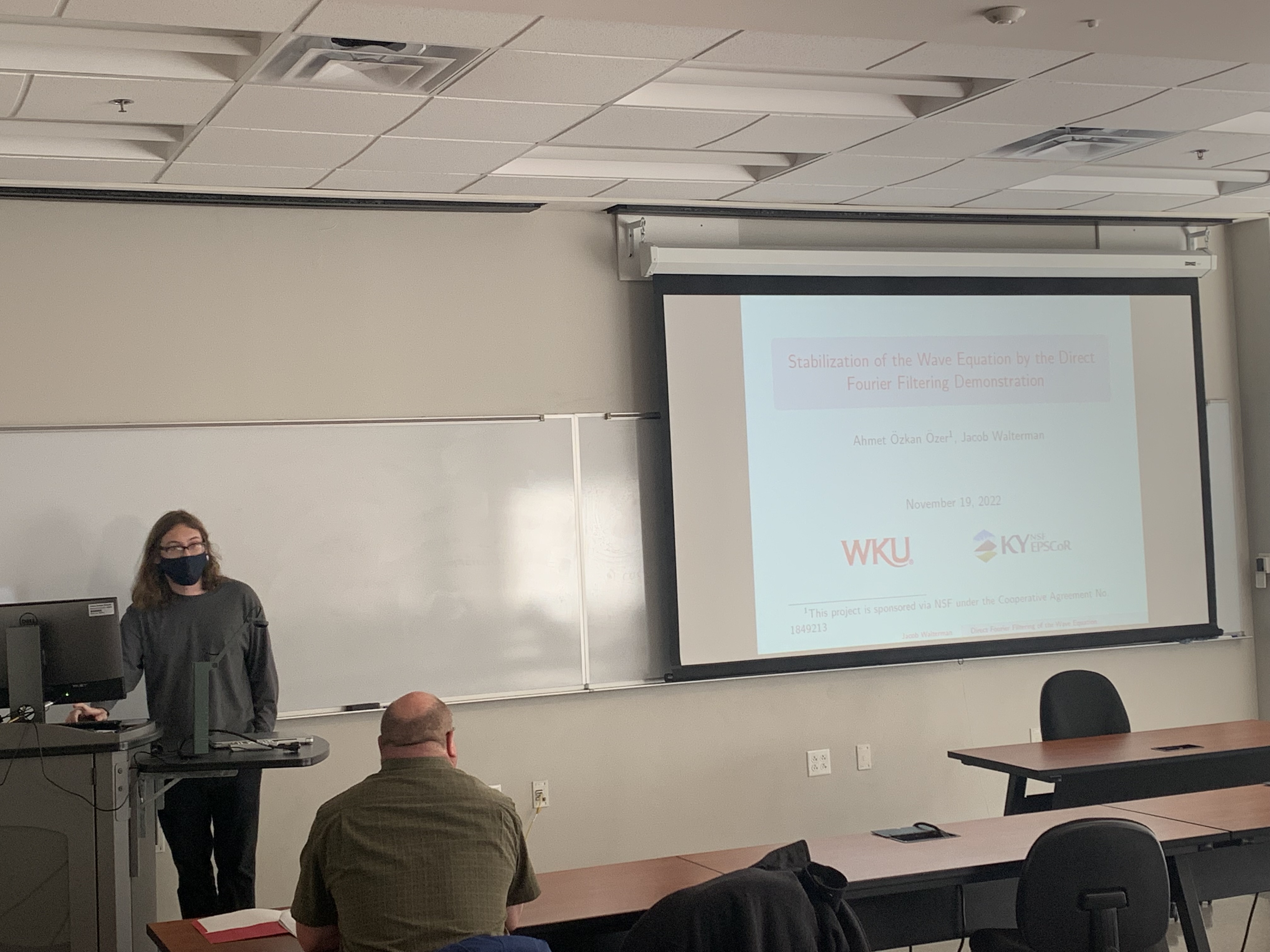
Click here to return to Detailed Schedule
Presenters: Matthew Poynter* (U), Ahmet Ozkan Ozer (F)
Affiliation: Western Kentucky University
Abstract: The piezoelectric effect is defined by a material’s ability to couple electrical gradients on its surfaces and internal stresses, and predictably exchange each one for the other. Vibrations on a piezoelectric beam are considered with a model that tracks both the physical longitudinal vibrations and the electrical displacements that occur. Such interactions are classicly modeled with a system of Partial Differential Equations (PDEs). In the chosen Piezoelectric beam model, two controllers inject damping through the right endpoint, and previous works have shown that the energy of vibrations will decay exponentially in the continuous model. However, former and existing graduate students’ works done here at WKU showed that some common discretizations like standard Finite Differences fail to preserve this exponential stability. We motivate and discuss a novel model reduction and numerical method to address this dilemma. A similar technique has proven successful in the case of other single PDEs which govern vibration, and it is our goal to examine both the convergence of such a model and prove its exponential stability.
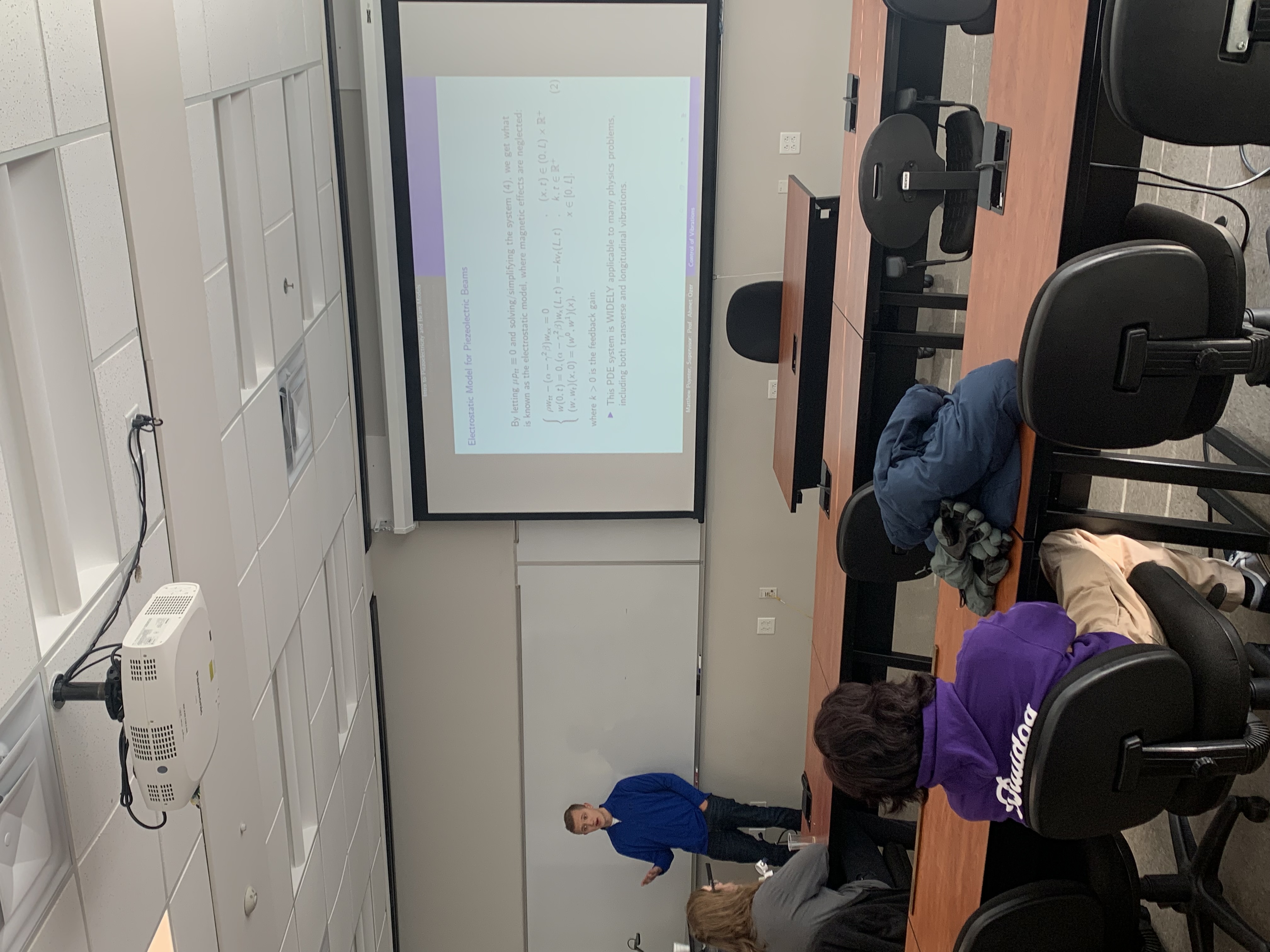
Click here to return to Detailed Schedule
Title: Playing Pool on a Sphere - Among other Surfaces of Revolution
Presenters: Ian Robinson* (U)
Affiliation: Murray State University
Abstract: Playing pool on a flat surface is fun, but what about playing on a surface of revolution? We investigate some dynamical properties of billiards, including periodicity and integrability, all while using an interactive Mathematica program to visualize what playing billiards on a curved surface would look like. If time permits, we also look at some numerical evidence for the existence of fractals in the phase space of certain billiard systems.
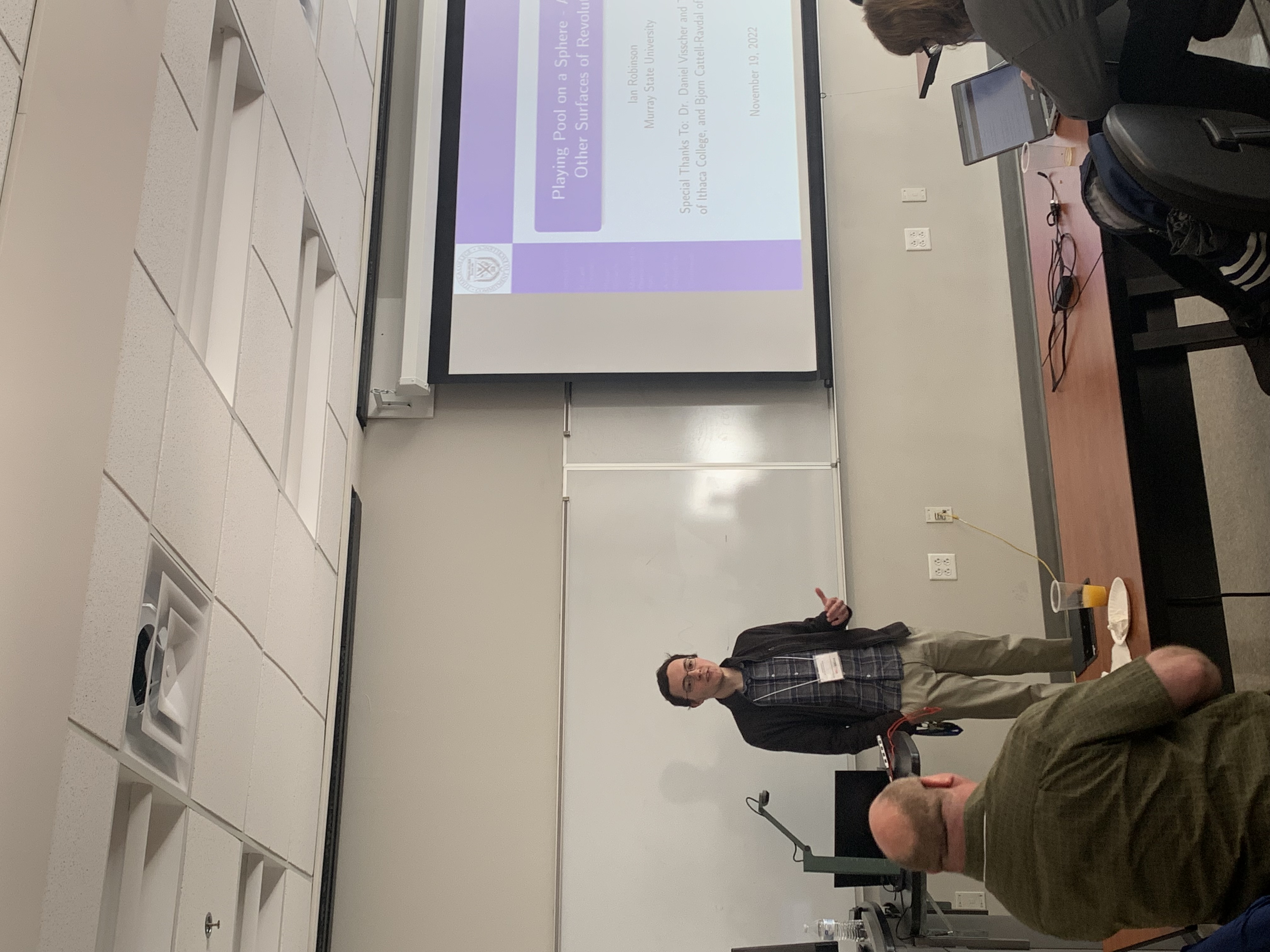
Click here to return to Detailed Schedule
Title:Wolfram Demonstrations Projects for the Feedback Sensor Design for a Multi-layer Sandwich Beam
Presenters: Jacob Walterman* (U), Ahmet Kaan Aydin (G), Ahmet Ozkan Ozer (F)
Affiliation: Western Kentucky University
Abstract: Consider a Finite Difference-based model reduction of a PDE model describing vibrations on a multi-layer beam with alternating layers resisting and allowing shear. The beam is hinged at both ends, and the right end is observed/controlled by a collocated sensor/actuator. As the sensor measures the rate of change of the tip velocity and uses the actuator to adjust the tip moments, all vibrations on the beam for the PDE model are known to be controlled to equilibrium exponentially fast. However, the solutions of the standard approach of semi-discretized approximations by Finite Differences are not
exponentially stable. Therefore, we introduce a dynamic boundary controller together with direct Fourier filtering. Finally, all control parameters and even the initial conditions of the beams positions and velocities can be manipulated via a live demonstration coded in Mathematica. This further confirms that the discretization model matches the real world. Earlier version of the demonstration for only three-layers is currently under peer-revision by Wolfram: https://demonstrations.wolfram.com/FeedbackSensorDesignForACantileveredThreeLayerSandwichBeam/
The demonstration to be shown in this talk is an upgrade of the earlier version to an arbitrary number of layers.
This project is sponsored by the National Science Foundation under Cooperative Agreement No. 1849213.
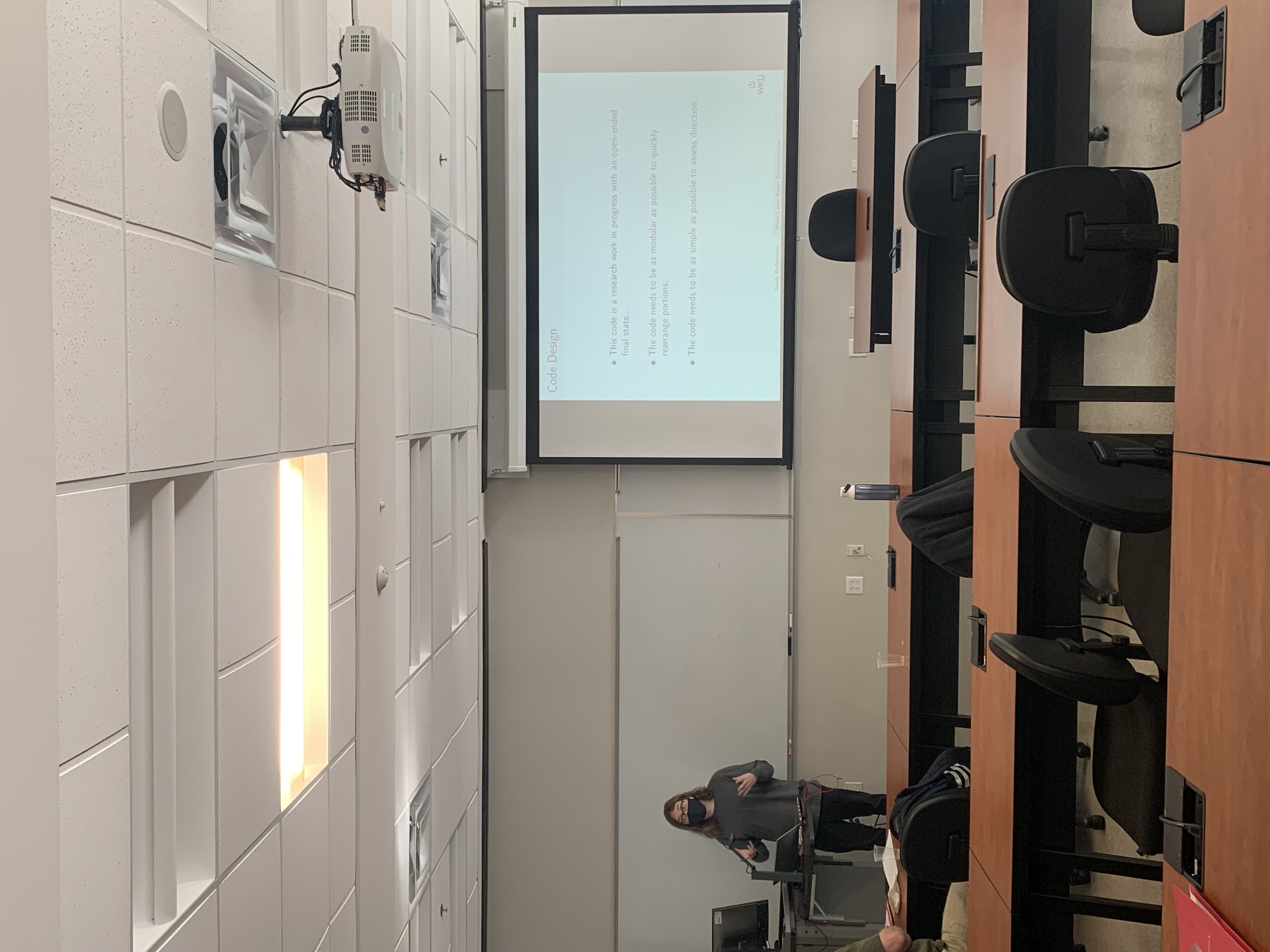
Click here to return to Detailed Schedule
Title: Strategies for d-Diet Chomp
Presenters: Daniel Trudell* (U), Eric Gottlieb (F)
Affiliation: Rhodes College
Abstract: Chomp is a combinatorial game that is played on an r × s grid where the lower left corner square is “poisonous.” Players take turns removing one square which in turn eliminates all squares above and to the right of the square they chose. Thus, in the course of play, a position can be described by an n-tuple (m1,…,mr), where mj denotes the number of squares remaining in the jth row. Play continues until a player is forced to choose the poisonous square.
d-Diet Chomp is a variation of Chomp in which only moves eliminating d or fewer squares from the board are allowed. Past research on 2-diet Chomp proves a board of type (m1,m2) is a losing position precisely when (m1- m2) ≡ 1 mod 3. Based on computer-generated evidence, we conjecture that a board of type (m1,m2) is a losing position in 3-diet Chomp precisely when (m1- m2) ≡ 1 mod 4.
We use Sprague-Grundy theory, a powerful tool for studying certain types of combinatorial games, to study 3-diet Chomp. In particular, we determine the Sprague-Grundy values of the board (m1,m2) for all positive integer values of m1 and m2.
Joint work with Professor Eric Gottlieb.
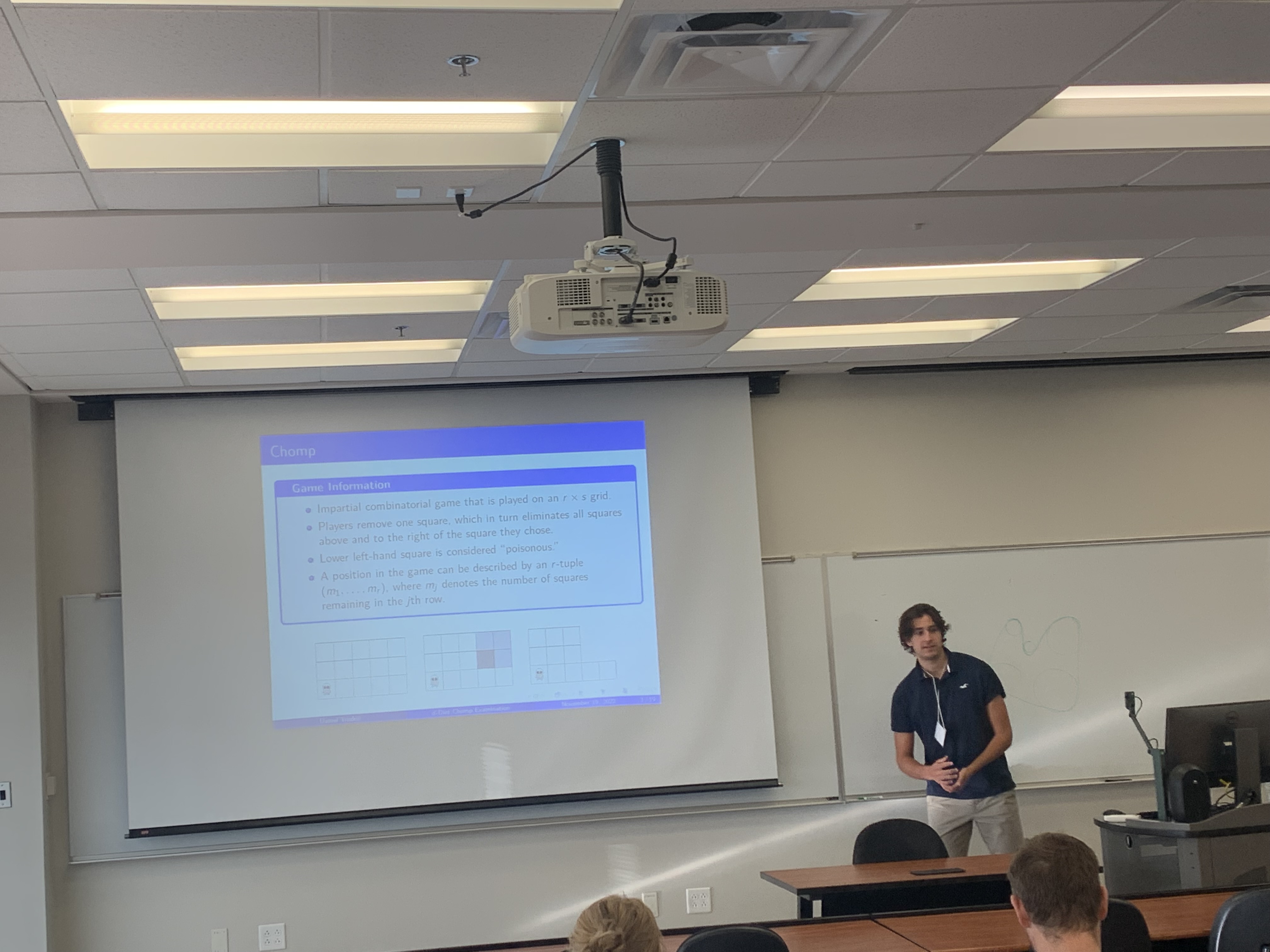
Click here to return to Detailed Schedule
Presenters: Brian Nguyen* (GA)
Affiliation: Gatton Academy
Abstract: Flow is a game where the user is provided an arbitrary n × n grid that contains an arbitrary m pairs of distinctly colored nodes. The objective of the game is to connect all pairs of nodes with one another given that
-
The connections do not overlap with one another.
-
The grid is entirely filled.
While Flow Free may be a game, it presents itself as a unique twist on graph traversal problems. In this project, we develop an efficient algorithm to deter-mine a solution to a Flow map using a modified depth first search.
Click here to return to Detailed Schedule
Title: Geodetic Ratio, Color Sequences, and Their Relation on Graphs
Presenters: Matthew Hendrix* (GA), Mustafa Atici (F), Aathman Bhavaraju (GA)
Affiliation: Gatton Academy
Abstract: For a given graph G, the definitions of a color sequence and a (t,k)-geodetic set are given in several papers. In this study, we give the definition of a geodetic ratio derived from (t,k)-geodetic and show the relationship between the geodetic ratio and the color sequence. There is no known polynomial algorithm to compute the geodetic ratio of a given graph G. We give a polynomial algorithm that gives an upper bound of the geodetic.
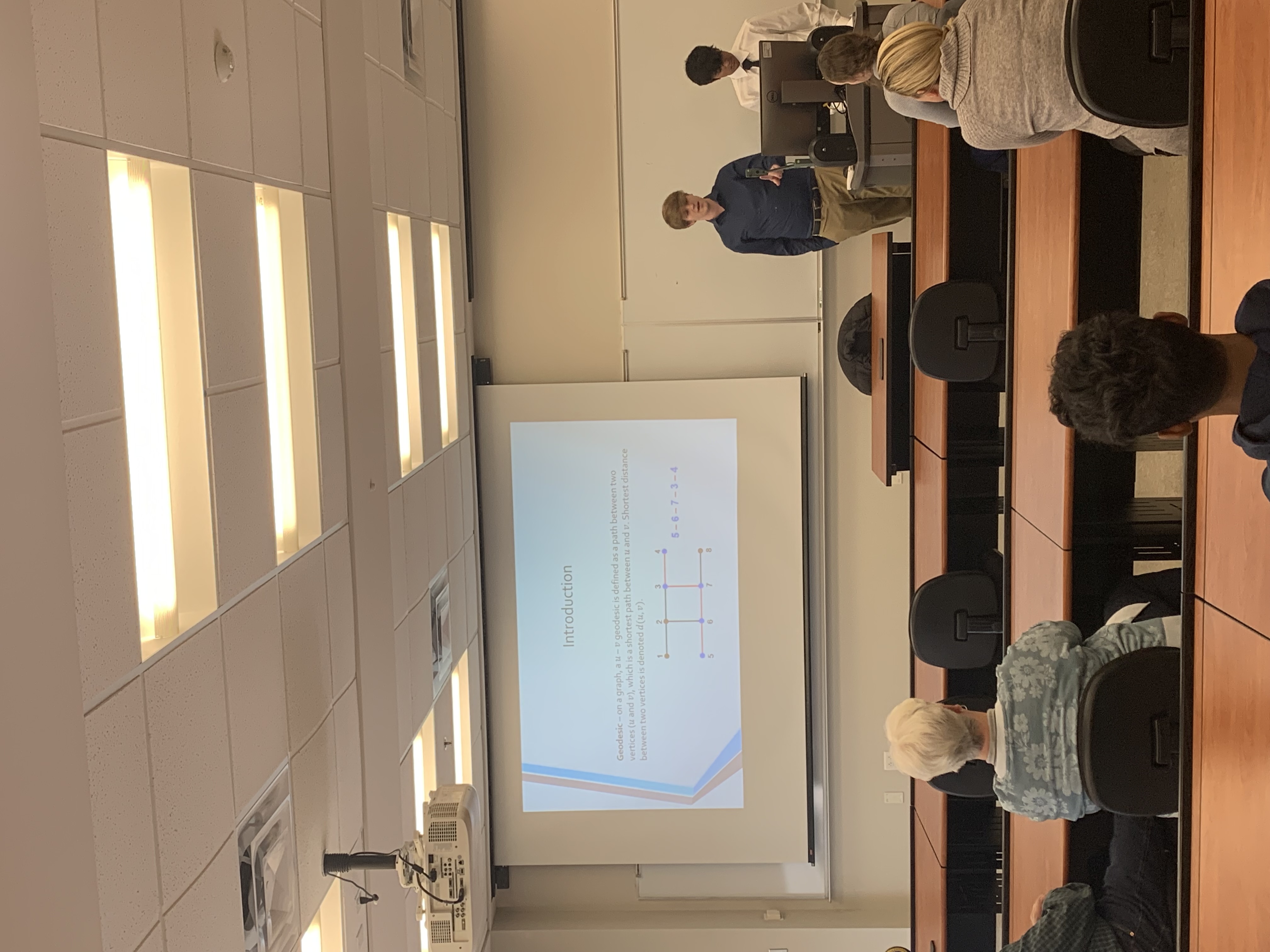
Click here to return to Detailed Schedule
Title: Interpretation and Assumptions, conditional probability
Presenters: Attila Pór* (F)
Affiliation: Western Kentucky University
Abstract: We look into versions of the following classical problem. We know that after flipping two coins, one of them is Head. What is the probability of the other being Tail? Does it matter if I flip the coin with my left hand, or if it spins 17 times?
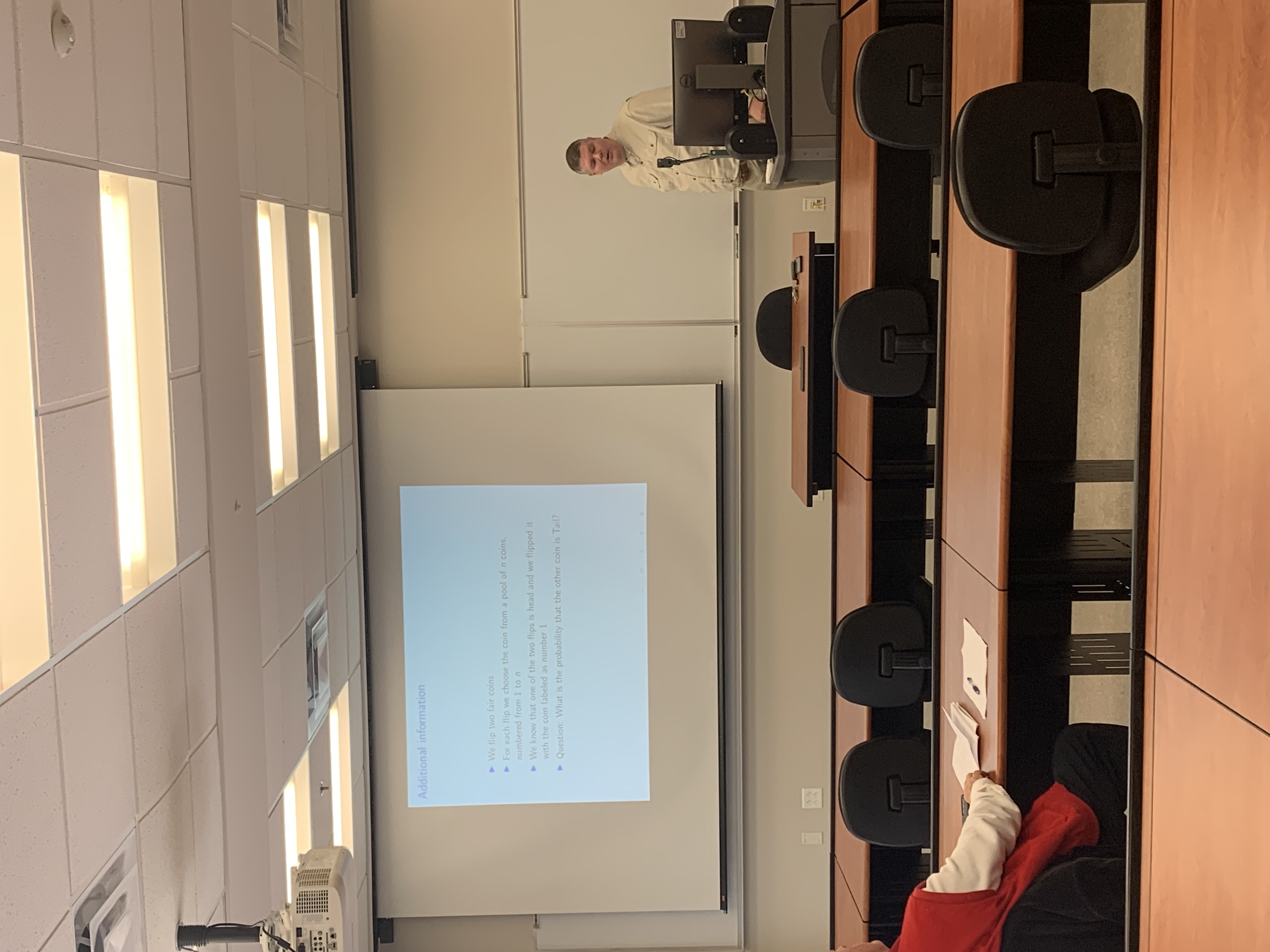
Click here to return to Detailed Schedule
Title: Geometric Proof on Fermat’s Two Square Theorem
Presenters: Brian Nguyen* (GA)
Affiliation: Gatton Academy
Abstract: In 1640, Fermat discovered that for any prime p 1 (mod 4), there exists integers x,y such that x2 + y2 = p. While Fermat is often credited for the theorem, Albert Girard was the first to observe
in 1625, and Euler came up with the first recorded proof in 1747. Since then, many
proofs have been identified, such as Don Zagier’s case on involutions or the utilization
of Gaussian integers. In this presentation, we will show one of the more elementary
proofs of the theorem that applies Minkowski’s theorem.The beauty of this particular
proof is that it demonstrates a powerful connection between primes and geometric results.
1 (mod 4), there exists integers x,y such that x2 + y2 = p. While Fermat is often credited for the theorem, Albert Girard was the first to observe
in 1625, and Euler came up with the first recorded proof in 1747. Since then, many
proofs have been identified, such as Don Zagier’s case on involutions or the utilization
of Gaussian integers. In this presentation, we will show one of the more elementary
proofs of the theorem that applies Minkowski’s theorem.The beauty of this particular
proof is that it demonstrates a powerful connection between primes and geometric results.
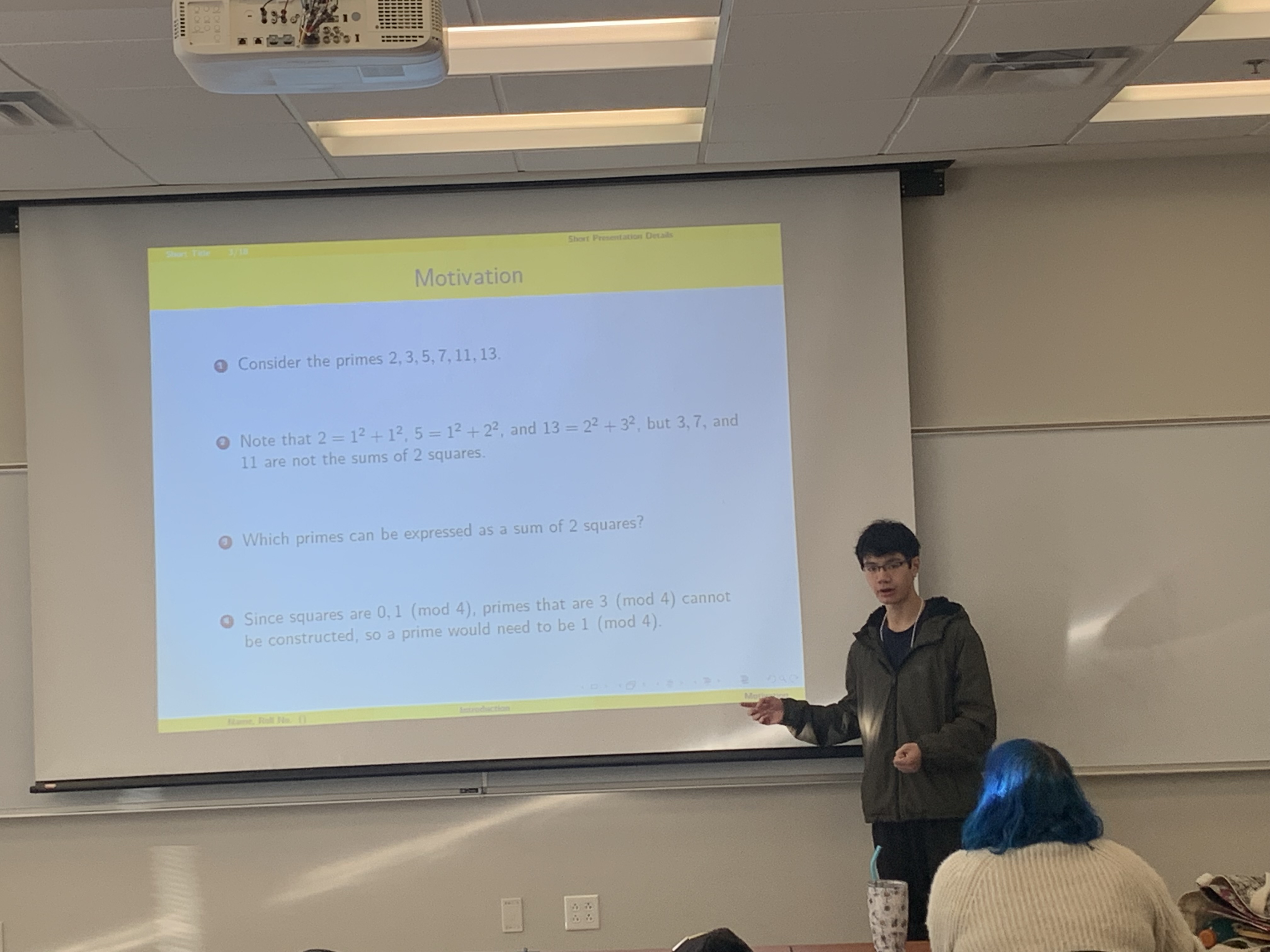
Click here to return to Detailed Schedule
Title: Integrating Functions via the Hilbert Embedding
Presenters: Lily Whitesell* (U)
Affiliation: Rhodes College
Abstract: Let G be a collection of n × n invertible complex matrices and define ![]() [x1,…,xn]G to be the set of polynomials in n variables that are invariant under G, meaning that they don’t change when elements of G are applied to the variables. In many circumstances, a theorem of Hilbert guarantees
that
[x1,…,xn]G to be the set of polynomials in n variables that are invariant under G, meaning that they don’t change when elements of G are applied to the variables. In many circumstances, a theorem of Hilbert guarantees
that ![]() [x1,…,xn]G is finitely generated. This means that it is the subalgebra of
[x1,…,xn]G is finitely generated. This means that it is the subalgebra of ![]() [x1,…,xn] generated by a finite set of polynomials f1,…,fk. Such a generating set is called a Hilbert basis. Given a Hilbert basis, the Hilbert embedding (a map f : V → ℝk) can be defined. This allows us to think of the orbit space as a subset of ℝk. The goal of my research is to integrate functions that are invariant with respect
to a group action over the orbit space via the Hilbert embedding. I am working to
discover a way to integrate a smooth function of invariant polynomials (by something
known as the Schwarz-Mather Theorem) in order to compute the integral of the invariant
smooth function. This is known as the “canonical measure” or “canonical volume form”
on the orbit space that pulls back via the Hilbert embedding to the ordinary volume
form. I will present computations of this canonical measure in some corregular cases,
including 2 particles in ℝ2, 2 particles on ℝ3, 3 particles in ℝ3, and progress on the case of 2 particles in ℝ4.
[x1,…,xn] generated by a finite set of polynomials f1,…,fk. Such a generating set is called a Hilbert basis. Given a Hilbert basis, the Hilbert embedding (a map f : V → ℝk) can be defined. This allows us to think of the orbit space as a subset of ℝk. The goal of my research is to integrate functions that are invariant with respect
to a group action over the orbit space via the Hilbert embedding. I am working to
discover a way to integrate a smooth function of invariant polynomials (by something
known as the Schwarz-Mather Theorem) in order to compute the integral of the invariant
smooth function. This is known as the “canonical measure” or “canonical volume form”
on the orbit space that pulls back via the Hilbert embedding to the ordinary volume
form. I will present computations of this canonical measure in some corregular cases,
including 2 particles in ℝ2, 2 particles on ℝ3, 3 particles in ℝ3, and progress on the case of 2 particles in ℝ4.

Click here to return to Detailed Schedule
Title: Harmonic Functions: Their Properties and Applications
Presenters: Wyatt Cooper* (U)
Affiliation: Western Kentucky University
Abstract: Every day, we are surrounded by real-world events and inventions, that when modeled through differential equations are found to be harmonic. These harmonic functions are utilized in applied mathematics, engineering, and physics. This research paper takes a look at what it means for a function to be called harmonic. Following, the paper dives into the properties that harmonic functions possess. With these properties, practitioners can better understand real-world phenomena. Adding context, the paper gives a few examples of applications in the world that utilize harmonic functions to help solve problems. Furthermore, there is a quick investigation of subharmonic and superharmonic functions. Finally, the paper concludes with a connection between harmonics and a known cyber attack.
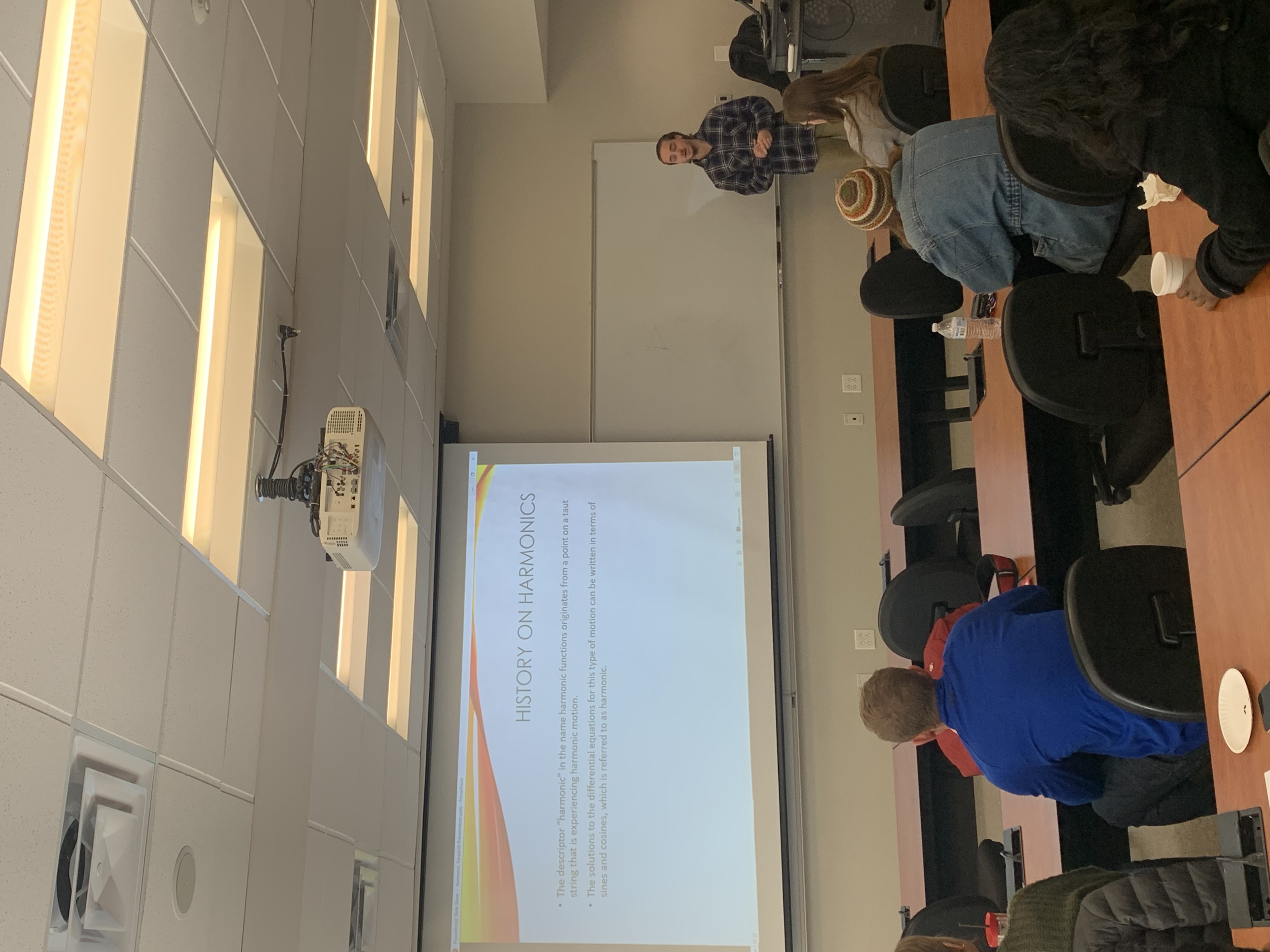
Click here to return to Detailed Schedule
Title: Heavy Quarkonium Dynamics in Quantum Phase Space Representation
Presenters: Gabriel Nowaskie* (GA)
Affiliation: Gatton Academy
Abstract: Since the groundwork of Torres-Vega and Frederick, the Quantum Phase Space Representation (QPSR) has been explored as a method for solving a multitude of physical systems and describing phenomena, and developments by Valentino A. Simpao have paved the way to solve system evolution through the Heaviside Operational Ansatz. While the wavefunction of heavy quarkonium in coordinate space has been solved, there is no current formulation for the phase space wavefunction of heavy quarkonium. In this paper, we describe strong interactions of nonrelativistic heavy quarks via use of a Cornell potential, consisting of a Coulomb-like term and a linear potential, and present a scheme to formulate the phase space wavefunction for any polynomial, scleronomic potential with an added reciprocal term.

Click here to return to Detailed Schedule
Title: What Makes a Successful Undergraduate Mathematics Class?
Presenters: Sophie Wielawski* (GA), Sarah Hartman (G), Nicholas Fortune (F)
Affiliation: Western Kentucky University
Abstract: This study reviewed characteristics of successful mathematics classes from the student, teacher, and content perspectives. To determine these characteristics, a literature review was conducted, using some of the leading research papers in undergraduate mathematics education. From the literature, some examples of these characteristics are the use of active learning practices in teaching and student-to-student interaction during class.
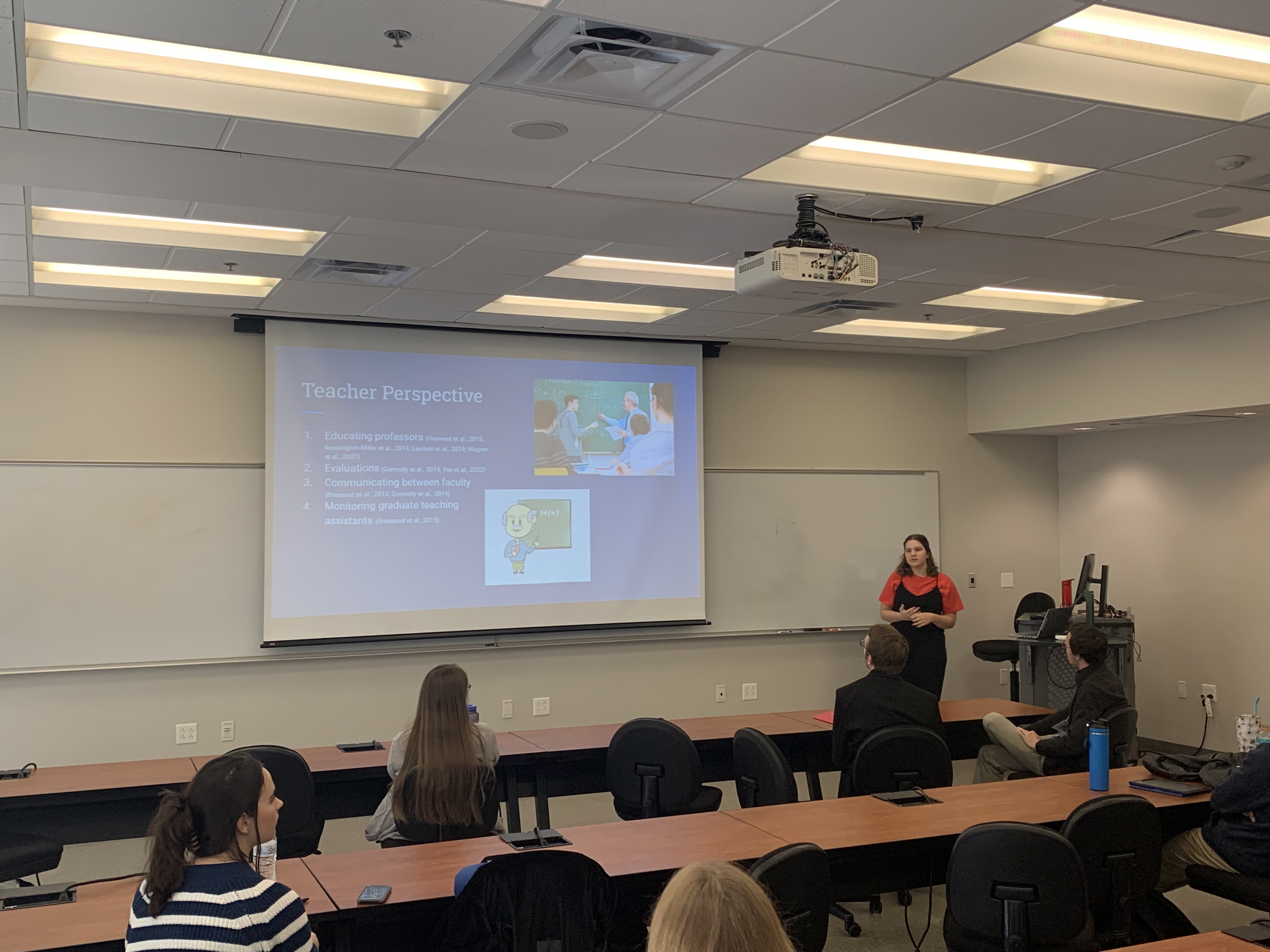
Click here to return to Detailed Schedule
Title: A Partial Differential Equation Population Model on a Patchy Landscapes
Presenters: Ryan St. Clair* (G)
Affiliation: Western Kentucky University
Abstract: Spatially heterogeneous ecology models are needed to better model population dynamics in natural and agricultural environments. Our research expands existing reaction diffusion population ecology models on patchy landscapes to include 3 or more unique habitat patch types. A general form of the implicit equation for the Sturm-Liouville eigenvalue problem is derived that is robust to different interface conditions between habitat patches and at the boundaries of the landscape. The model gives results regarding the susceptibility of a landscape to invasion and the persistence of a population on a landscape, and model predictions are explored for applications regarding earthworms in natural and agricultural settings. Model predictions regarding migration dynamics, population growth, and organism behavior in heterogeneous patchy landscapes are also interpreted through the ecological frameworks of source-sink theory and forage theory.
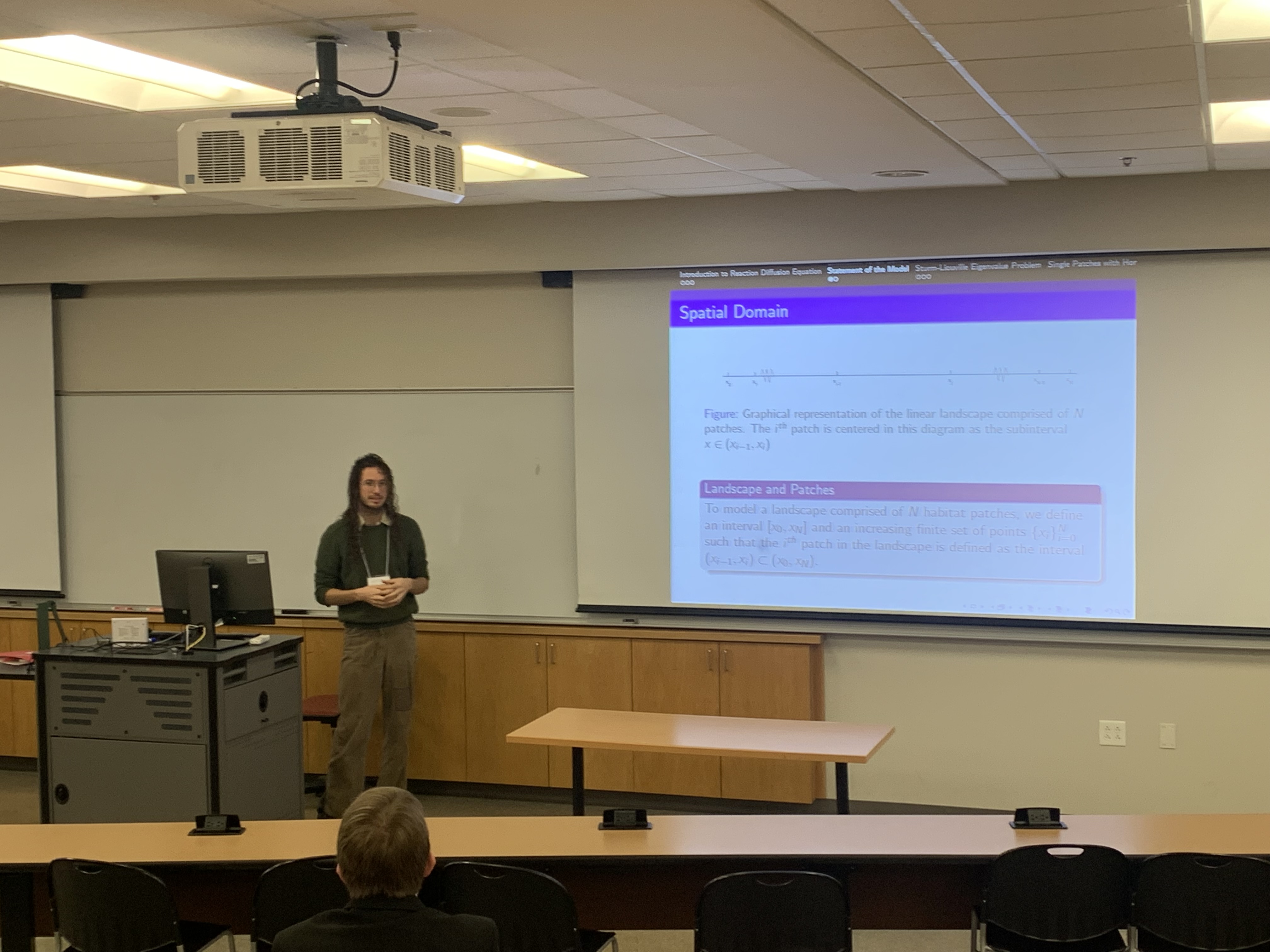
Click here to return to Detailed Schedule
Title: Solutions of First Order PDE with Two-Dimensional Dirac Delta Forcing Terms
Presenters: Ian Robinson* (U)
Affiliation: Murray State University
Abstract: We investigate the properties and solutions of first order PDE in two variables where the nonhomogeneous term takes the form of a two-dimensional Dirac delta function. Upon discovering why it is useful to treat the Dirac delta ”function” as a distribution instead, a discussion of uniqueness and existence of weak solutions of this class of PDE is provided. We conclude by looking at some concrete examples and their solutions.
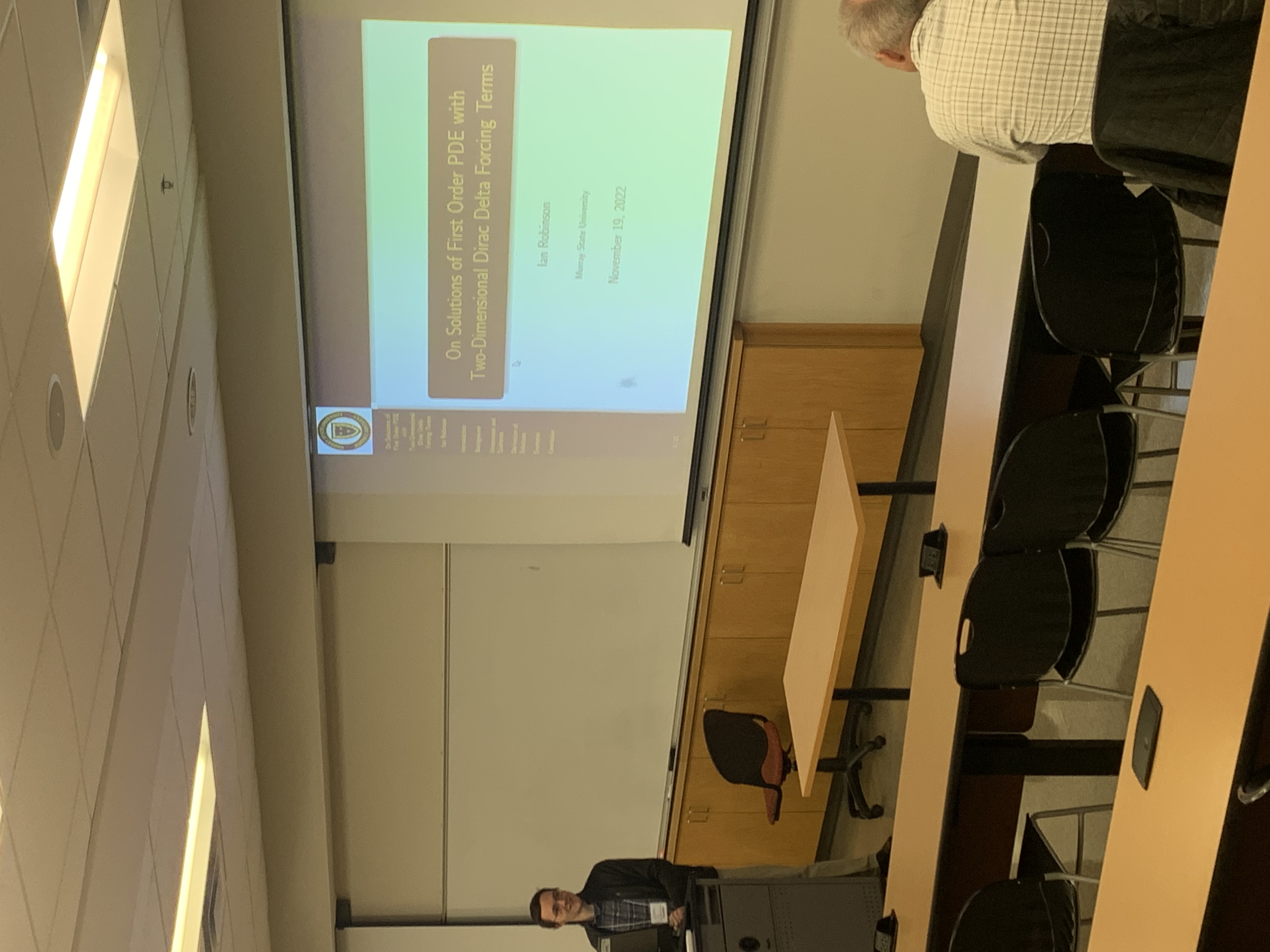
Click here to return to Detailed Schedule
Presenters: Md Rafi As Sadeq Ibn Emran* (G)
Affiliation: Western Kentucky University
Abstract: Piezoelectric materials are smart materials having the ability to interchange mechanical energy(longitudinal vibrations) and electromagnetic energy (voltage, charge, etc.) during the motion.Therefore, they can be used as both sensors and actuators. A coupled PDE system of wave equations, describing the mechanical vibrations and its interactions with electromagnetic fields,is considered with the design of co-located sensors/actuators at the tip of the beam. The sole task of these sensors is to collect data (tip velocity and total current) and feed it back to the actuator (strains and voltage). In this talk, the exponential stability of the vibrations for the closed-loop design (in the PDE setting) is proved first. To obtain the same result, an in-famous Finite-Differences-based approximation technique is adopted. However, the standard use of this technique leads to the lack of uniform observability (sensor numbness) as the approximation parameter tends to zero due to the computer-generated high-frequency vibrational modes. Recently, a direct Fourier filtering technique is successfully utilized for a sensor design only [Horner-Ozer, GAPA, 2021]. This is essential for the exponential stability result. However,further calculations and discussion are needed to prove exponential stability by Lyapunov-based approach. In order to apply this approach together with proper filtering of the numerical scheme,we needed to learn how this method works for a single wave equation which, to the best of our knowledge, is a novel work itself in the literature. By gaining more insights into this approach,currently, we are at the stage of applying this idea to the strongly coupled wave equations for the piezoelectric beam. In this talk, submitted results for publication together with the ongoing work will be discussed. These results will be directly used for robust designing of actuators/sensors for piezoelectric beams.This project is sponsored by the National Science Foundation under Cooperative Agreement No.1849213.
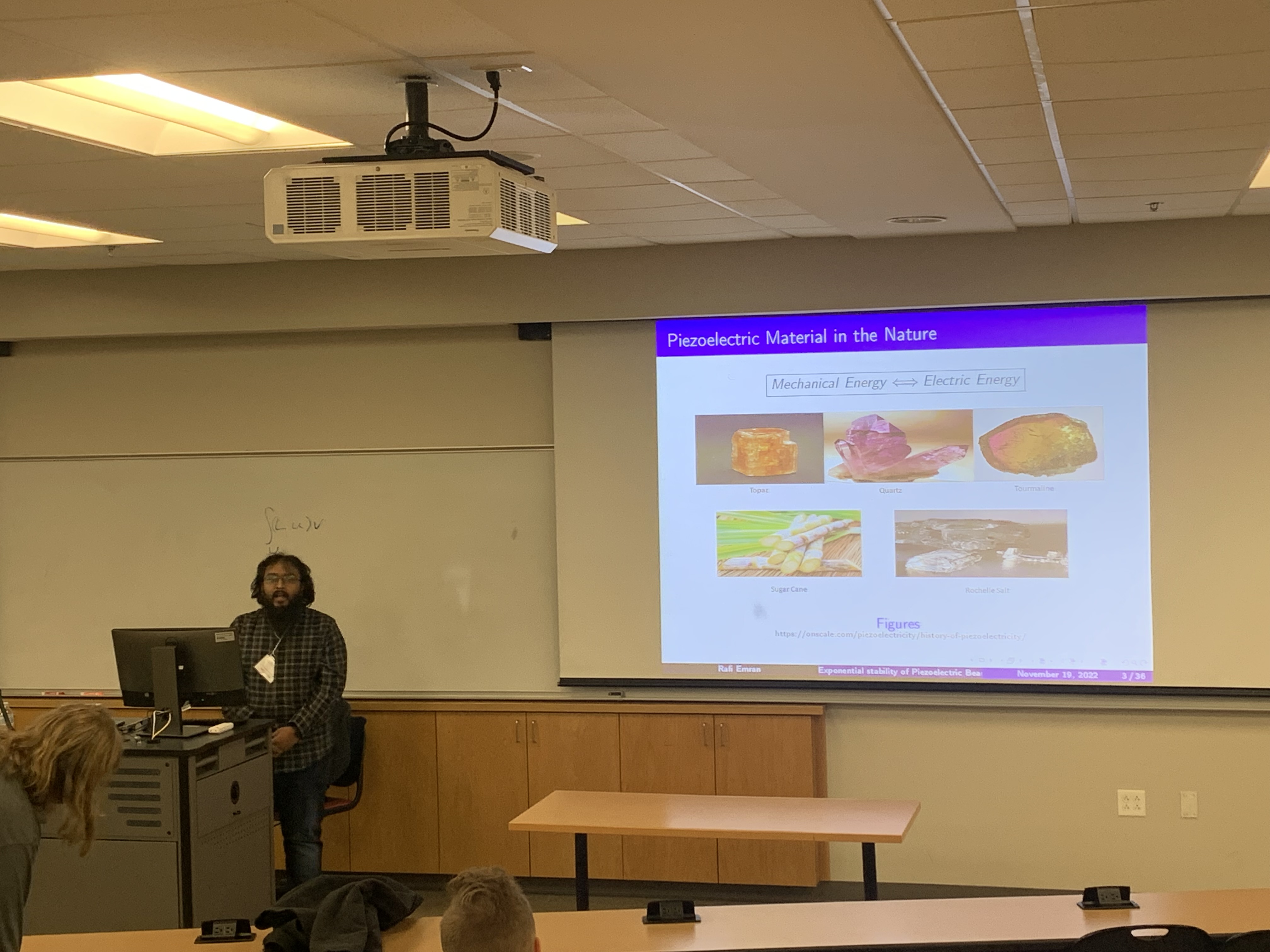
Title: Determining the Optimal Launch Conditions of Small-Scale Orbital Satellites
Presenters: Nathan Hogg* (HS)
Affiliation: Rowan County Senior High School
Abstract: Satellites are vital to the functionality of our ever-evolving technological world. They are the go between for nearly all Earth based communications, global Positioning Systems, and various other technologies. As of 2022, there are 4,500 satellites in orbit around the Earth, with more being launched each year. Given the small margin of error for these launches, there are many mission-critical calculations that must be made for each launch. These calculations range from weather forecasts to differential equations. This project aims to simplify this process by providing the user with an easy-to-use interface to make these calculations.
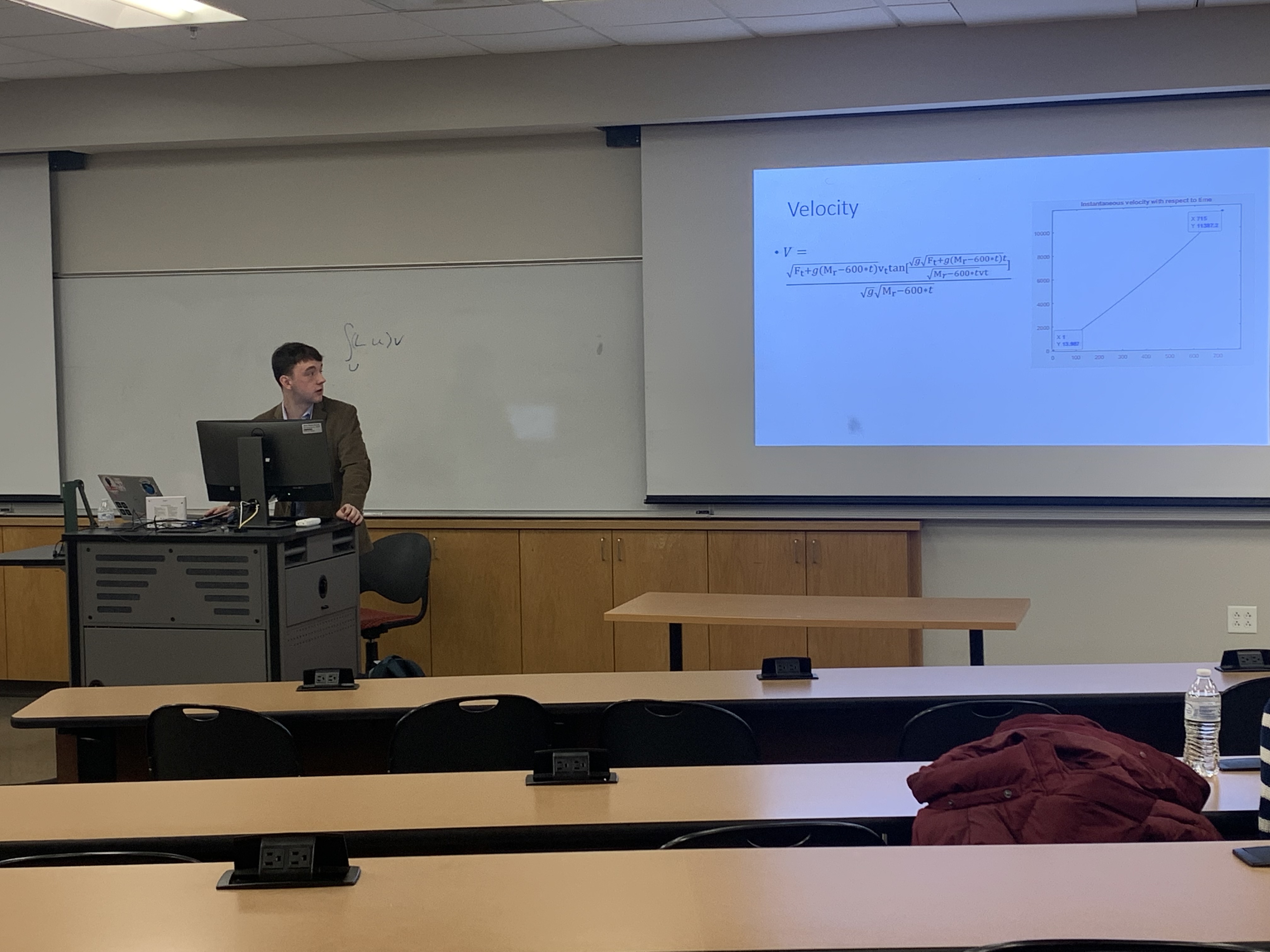
Click here to return to Detailed Schedule
Title: Approximating Prime Numbers with Functions Generated by a Genetic Algorithm
Presenters: Kaden Yonts* (GA), Jonathon Reilly* (GA), and Eli Cossel* (GA)
Affiliation: Gatton Academy
Abstract: The project focuses on using genetic algorithms to select functions that generate approximations of prime numbers. A user will be able to determine certain criteria of the selection process such as the number of generations the selection process will run for. This project will use the MATLAB Symbolic toolbox that deals with the creation of genetic algorithms.
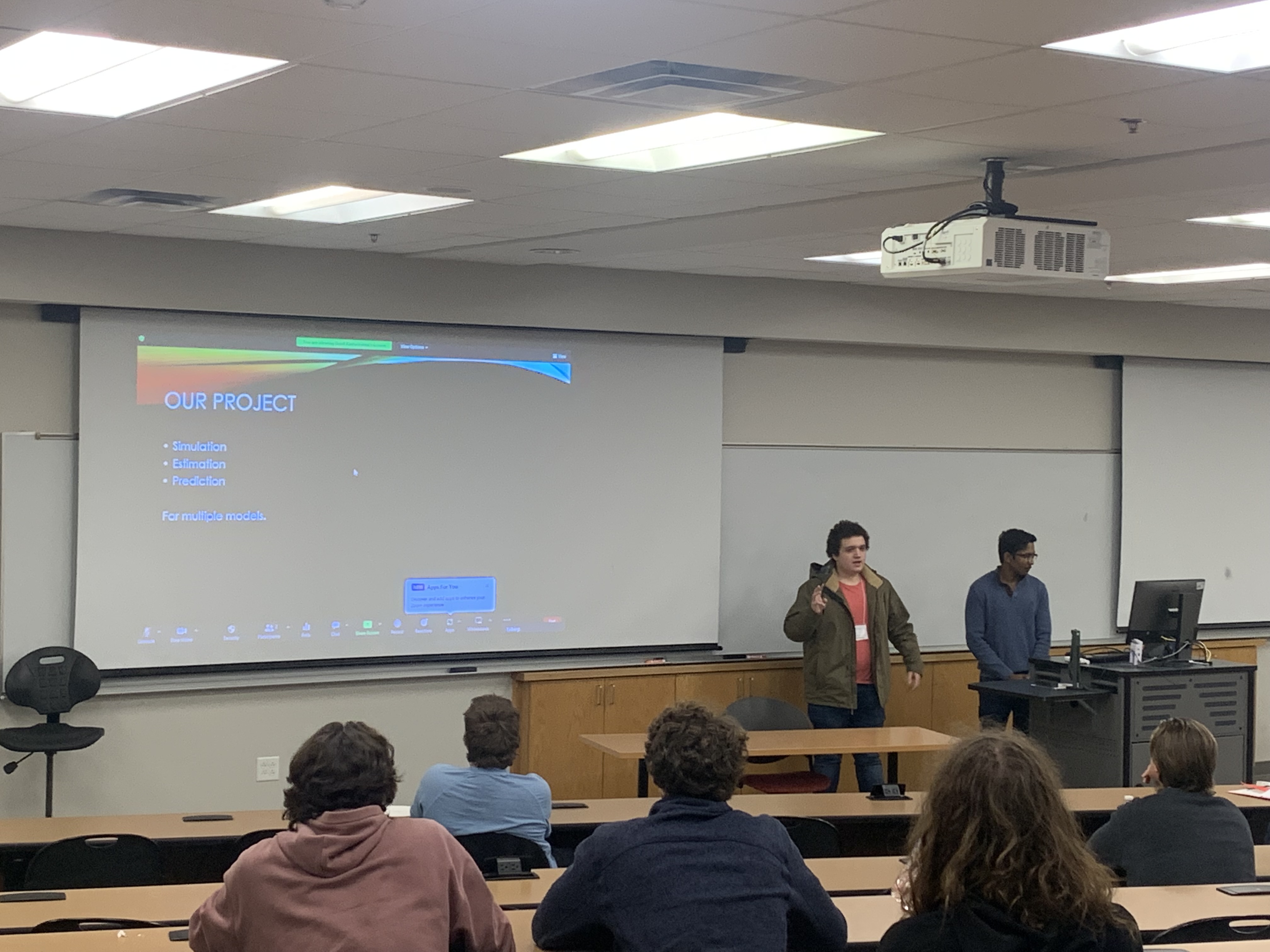
Some of the links on this page may require additional software to view.



